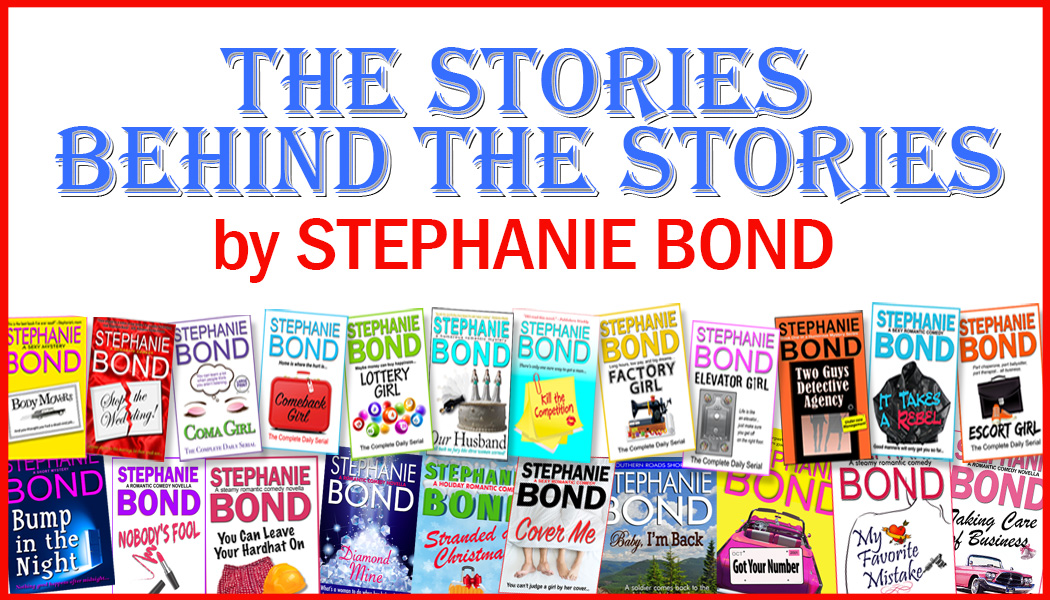
Hello! Thanks so much for your interest in my books and my journey to become (and stay) a working novelist! As of this writing, I’m (gulp!) thirty years into my author career, which, by the way, was a second career for me. In that time I’ve written dozens of romance and mystery novels; to be honest, I’m not sure of an exact number because some of them are novellas or short stories or serials, and there have been many reprints and combined anthologies over the years, and various translations.
When I hear from readers, the repeated refrains are “How did you get into writing? Where do I start reading your books? Which ones are related or are in a series? Why are there different covers online for the same book? Which ones are available in non-English languages? Do you have a booklist I can use to shop with?”
In other words—I’ve written so many stories over the years for different publishers and to self-publish, there’s a bit of confusion about what’s what, what’s old, what’s new, and what’s next. This page is meant to be part-memoir/part enhanced booklist to give you a peek into my life and the stories behind the books you might’ve enjoyed or missed. I’ll be sharing personal photos along the way, anecdotes about breaking into (and exiting from) New York publishing, resources I’ve used, and links to my books that are available. I’ll be publishing chapters at regular intervals throughout 2024. I hope you'll bookmark this page and visit again soon. And please share with reading and writing friends you think might be interested in THE STORIES BEHIND THE STORIES.
Happy Reading!
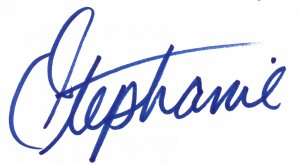
__________________________________________________
Click on links below to start reading—at the end of each chapter you'll be able to link to the next chapter. Or you can scroll down this page to read chapters in reverse chronological order.
Chapter 1: Before the Writing Bug Bit Me
Chapter 2: My Writing Journey Begins
Chapter 3: Writing and Selling My First Book
Chapter 4: Becoming a Full-Time Writer
Chapter 5: Writing Full Time, Sink or Swim
Chapter 6: Keeping My Head Above Water
Chapter 7: I Got This (I Think)
Chapter 8: Pivoting to New Romance Publishing Lines
Chapter 9: Steamier Romances... and a New Challenge
Chapter 10: Dialing Up the Pressure
Chapter 11: Keeping on Keeping On
Chapter 12: A Busy, Busy Year!
←Return to Chapter 11: Keep on Keeping On
It was 2000, a year when I would have a total of five projects released, including my first "single title" romantic comedy mystery. In the last chapter I mentioned the first of those five projects—an interactive story called "A Funny Thing Happened on The Way to the Wedding" that I wrote for the Harlequin website, an innovative concept at the time. When I looked back through my archives, I found an article from Romantic Times Book Reviews magazine covering the launch of the Harlequin.com website—if memory serves, Harlequin was the first publisher to have a website—they were way ahead of their competitors! As was common at the time, Harlequin.com teamed up with another website, Women.com, for synergy. Although the two websites no longer collaborate, they're both still in business. Over the years Harlequin's website has morphed from rudimentary to high-tech, with its own shopping interface.
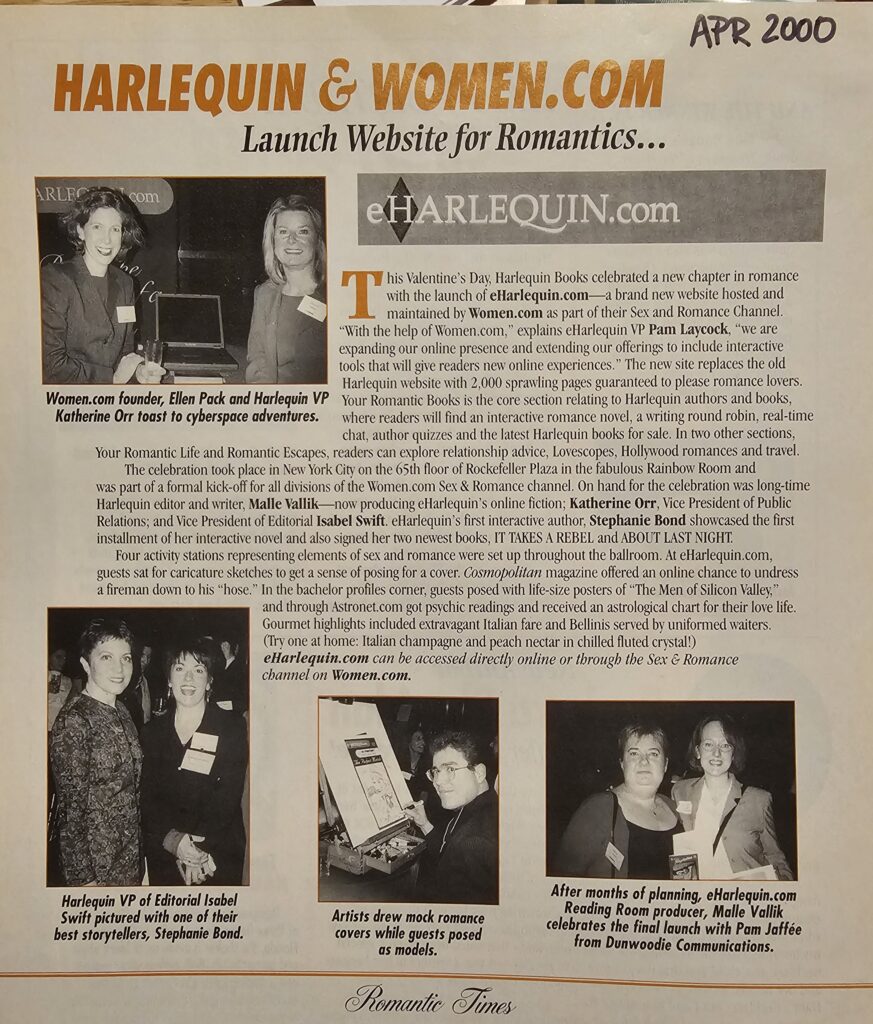
Romantic Times covers the launch of Harlequin.com and my interactive story, a first of its kind. That's me in the bottom left photo with Harlequin executive Isabel Swift.
My career was starting to pick up steam and I was getting a reputation for writing romantic comedies. A few months prior, my agent had received a request from an editor in the UK branch of Harlequin (Mills & Boon) asking me to submit a proposal for a "chaste" romcom for their sweeter romance line. I was eager to work for the line because it had a much larger readership. I pitched an idea I called Stop the Wedding about a man and a woman who join forces to stop their parents from marrying and fall in love themselves. The editor liked the idea, but said her boss wasn't sold on incorporating humor into the line, so I would have to submit a finished manuscript before they would offer me a contract. So in between everything else, I'd completed the manuscript on speculation and submitted it, and hoped the editors across the pond would like it. More on that project later!
In the previous chapter, I also mentioned my second project of 2000, a romantic comedy titled It Takes a Rebel, one of my most acclaimed books in terms of awards (and the sequel to About Last Night), which I've since updated and re-released:
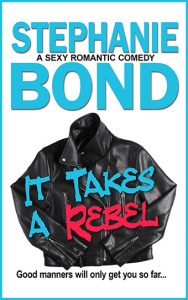
It Takes a Rebel, newly updated and available in ebook, print, and audio
I was also busy writing how-to articles for my local newsletter for Georgia Romance Writers and for the Romance Writers Report, the monthly magazine for members of Romance Writers of America.
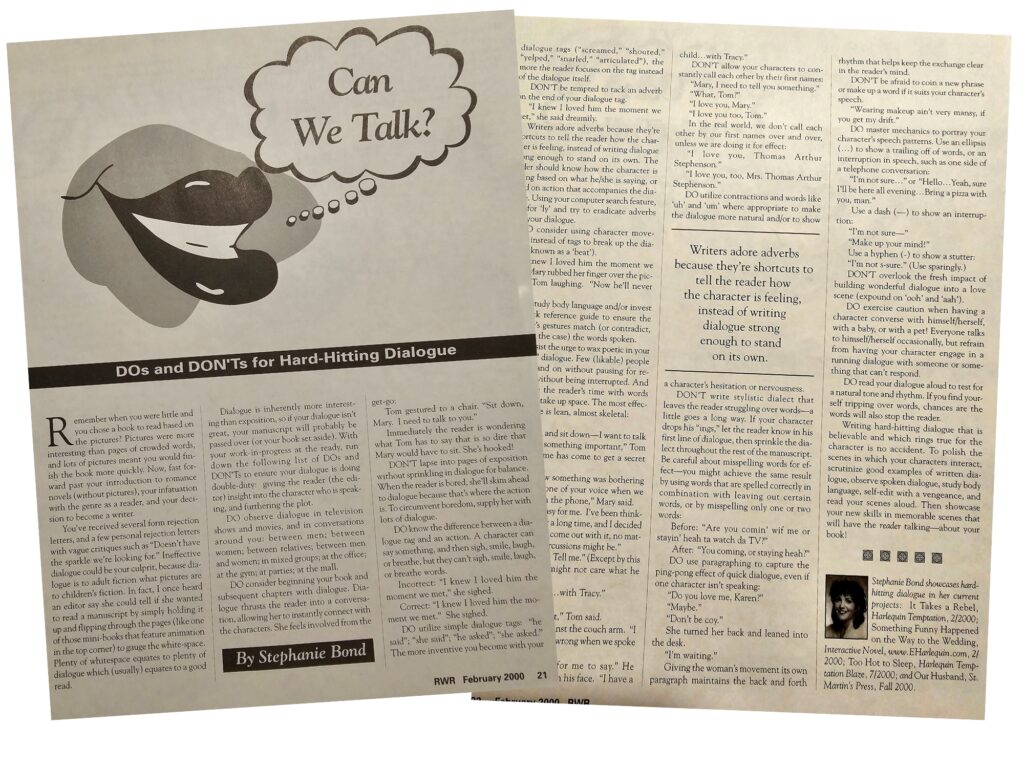
Article in the Feb 2000 issue of Romance Writers Report
I enjoyed writing how-to articles and teaching workshops, and I came to realize that both were good marketing tools for getting my name out among my peers. You might be wondering how I had time to write articles in between writing books… sometimes I wonder that myself when I look back! But switching from fiction to nonfiction is a bit like cleansing the palate—writing articles was a nice break between projects—they require different writing muscles. After writing an article, I could always go back to writing my stories with a clearer head and renewed energy.
And I needed my energy! For my next book in the Temptation line, I'd been asked to write a story for the wildly popular "Blaze" miniseries within Temptation. Books with the Blaze insignia were supposed to be more sensual with a sexy premise inherent to the plot line (versus a generic story with amped-up love scenes). I'd pitched what I hoped was a sexy premise to my editor Brenda Chin in four words: phone sex, wrong number. She loved it and I went away to come up with a story to wrap around the provocative premise. And I think I came up with something pretty decent for the story I titled Too Hot to Sleep:
A woman with a new boyfriend is frustrated with his lack of um, heat and decides to call him up and initiate phone sex in the hopes it takes their relationship to the next level. BUT she dials the wrong number and unknowingly has a steamy session with a stranger, who goes along with it thinking they'll never meet. When their paths cross unexpectedly, the man recognizes the woman's name and voice instantly, and she's everything he's ever wanted, but he can't tell her the truth or things will end before they get off the ground. The kicker is the woman has saved her boyfriend's number incorrectly in her phone and keeps calling the (right) wrong number!
Okay, friend, try to remember this was 2000. Almost twenty-five years ago. (How is that possible???) The latest in home phone technology in 2000 was a cordless landline phone—most people still had a phone with a curly cord (remember those?). If you did have a newfangled cordless phone with a tiny screen, Caller ID was an add-on luxury option, and you had to pay extra for the star-69 "call back" feature that allowed you to call the number that had last called you. So it was totally feasible that my heroine and her new-ish boyfriend weren't in touch every hour on the hour and because she's a nurse in the E.R., they wouldn't be talking during the day. Also, I had her boyfriend go out of town for business, which gives the hero a few days to keep up the ruse. And because in 2000, people still paid extra (and dearly) for long-distance phone calls (which now seems insane), it makes sense her boyfriend wouldn't call from across the country simply to chat. With all of those things in mind, my plot was completely believable. I had SO much fun writing the story! And Harlequin gave me a GREAT cover for Too Hot to Sleep (notice the red phone with the curly cord in the lower right corner):
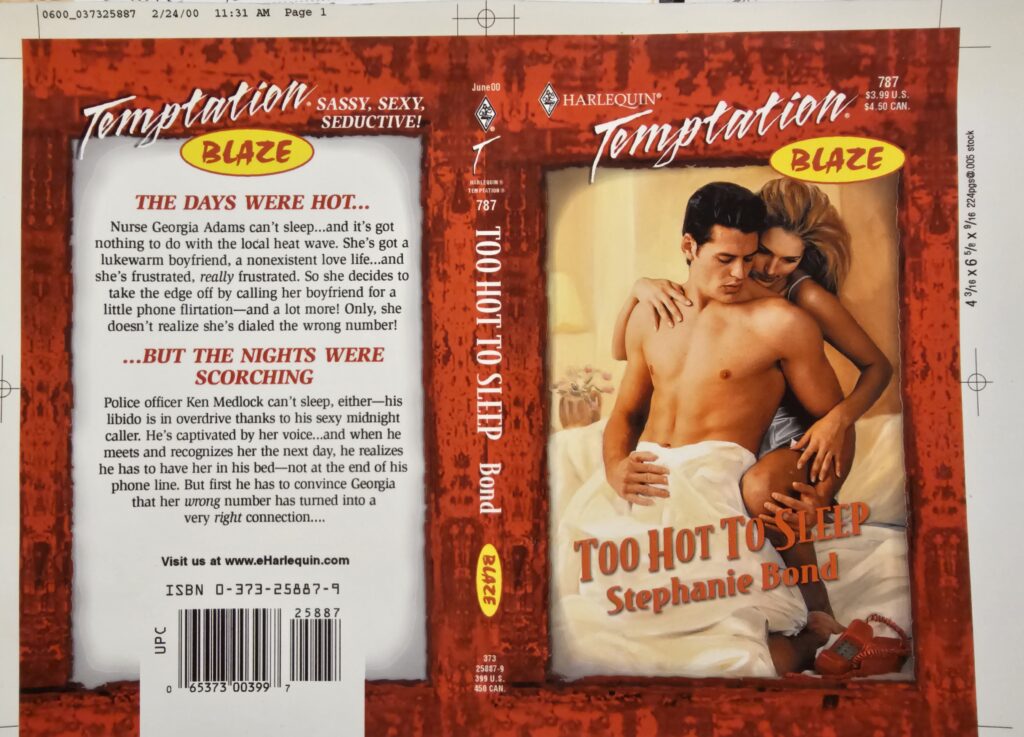
Original cover for Too Hot to Sleep, a book headed for controversy! This is the proof sheet for the cover, which was used to print the entire cover which was then wrapped around the bound text.
The excitement over the Blaze miniseries was high and Harlequin was getting great publicity for it.
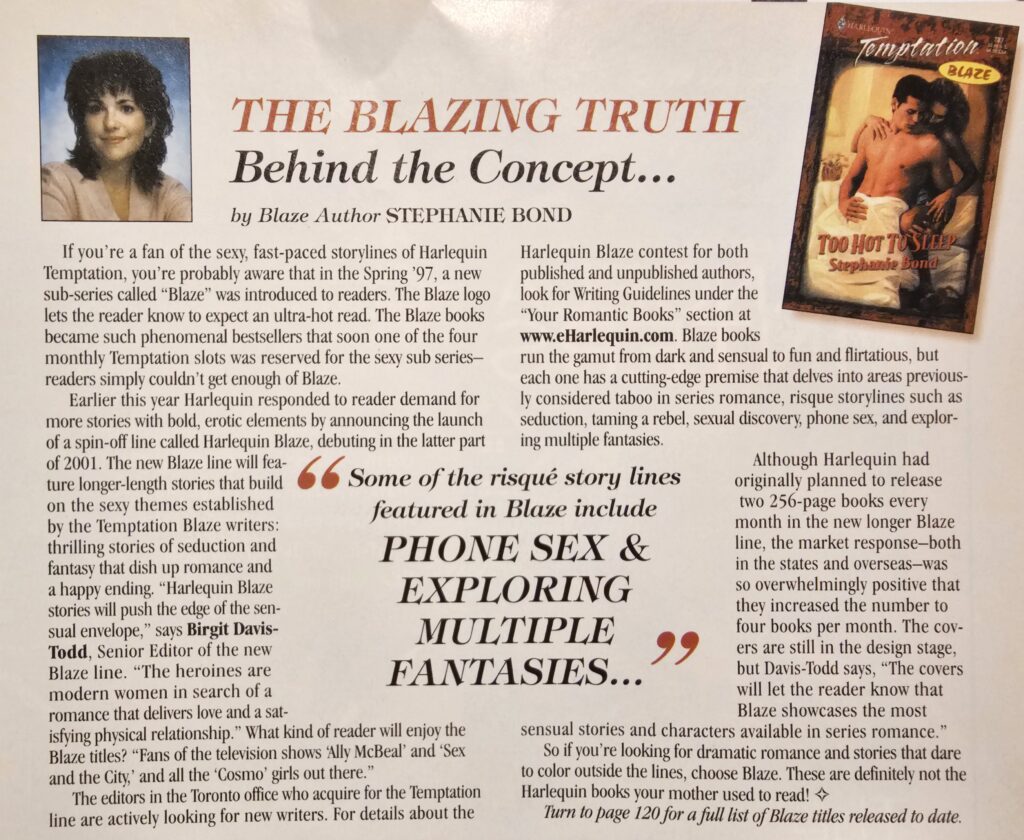
Romantic Times Book Reviews article I wrote regarding the popularity of the Temptation Blaze miniseries.
I was really excited about what reviewers and readers would think about the edgy romcom I'd written for the miniseries. And the reviews were… brutal! To be honest, most reviewers wouldn't touch my book because of the subject matter. Romantic Times Book Reviews magazine didn't give their reviewers the option not to review a category book—every category romance book got a review and a rating of from 1 to 4½ stars. A "1" designated the book as "severely flawed" and basically was a warning to readers to NOT buy it or read it. It was so rare to give a book 1 star that the editor of the magazine instigated a policy where she would personally phone any author whose book received a 1 to prepare them (and their publisher) for the hit. And I got that call. Ack. I was stunned and my ego was bruised. The reviewer basically thought the premise of the book and the love scenes over the phone were objectionable. Luckily, my editor and the Harlequin staff didn't agree—they stood by the book. But I braced myself for low sales and to be pelted with rotten tomatoes!
Instead, the 1-star review created a backlash from readers who disagreed, and generated interest from curious readers wondering how naughty the book must be to be designated "objectionable." Too Hot to Sleep turned out to be one of my best selling category romances! It was my first book to make the Waldenbooks/Brentano's (remember them?) top ten bestselling category romance list, and it was reprinted several times over the next couple of decades. And honestly, when compared to the content of some books (including Young Adult books) and TV shows these days, my book is now considered simply "sensual" or "steamy." My, how things have changed.
Including phone technology! When I got the rights to Too Hot to Sleep back from my publisher a few months ago, I confess I wasn't looking forward to updating the book and bringing it into 2024. I would've had to unravel so much of the story, then build it back in a more convoluted way in order to sidestep the advances in phone technology and the way people communicate now. It would've ruined the spirit of the story. So I decided to go another way and make it a "story within a story" that allowed me to keep most of the original story intact (although I did update the writing itself). And I added a few chapter illustrations, like I've been experimenting with in most of my recent books to make the story more special. I really like the nostalgic feel of the book, back when malls were the place to hang out and voice messages on phone machines could make or break a person's day! I hope you like the way I handled the update of Too Hot to Sleep, now with a fresh new cover (featuring one of those curly-cord phones!). Too Hot to Sleep is available to pre-order now, for release Friday, December 6. The ebook will be available exclusively on Amazon and in Kindle Unlimited through the first week of March, then it'll be available on all the online retailers. The print version will be available by December 10.
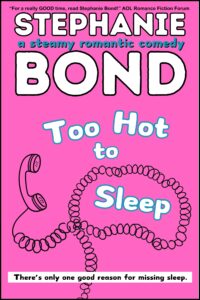
Too Hot to Sleep, newly revamped for re-release December 6 with a "retro" cover—preorder the ebook now!
I still had two more books to release in 2000, but I'll save those for next time. Suffice to say I was spending nearly every waking moment writing proposals for new books, finishing contracted books, or marketing the books coming out. But I was having the time of my life, doing what I loved, and starting to feel like I was justified in leaving my good corporate job to become a freelance fiction writer.
But I was nervous, too, because my first single title book, a romantic murder mystery, would be released in a couple of months and I needed for it to be well received if I was going to grow my career, my readership, and my income. ~
←Return to Chapter 10: Dialing Up the Pressure
It was 1999 and the entire planet was consumed with the countdown to the year 2000 and the widespread chaos and anarchy that would surely follow when computers spontaneously detonated. (In case you weren't born yet, none of those things happened. The worst part was it took everyone several months to learn to write "20XX" on their bank checks instead of "19xx"… back when writing checks was still a thing!)
I was still doing signings for my February '99 release CLUB CUPID (newly updated and re-released if you missed it) and gearing up for my next release ABOUT LAST NIGHT in October of that year.
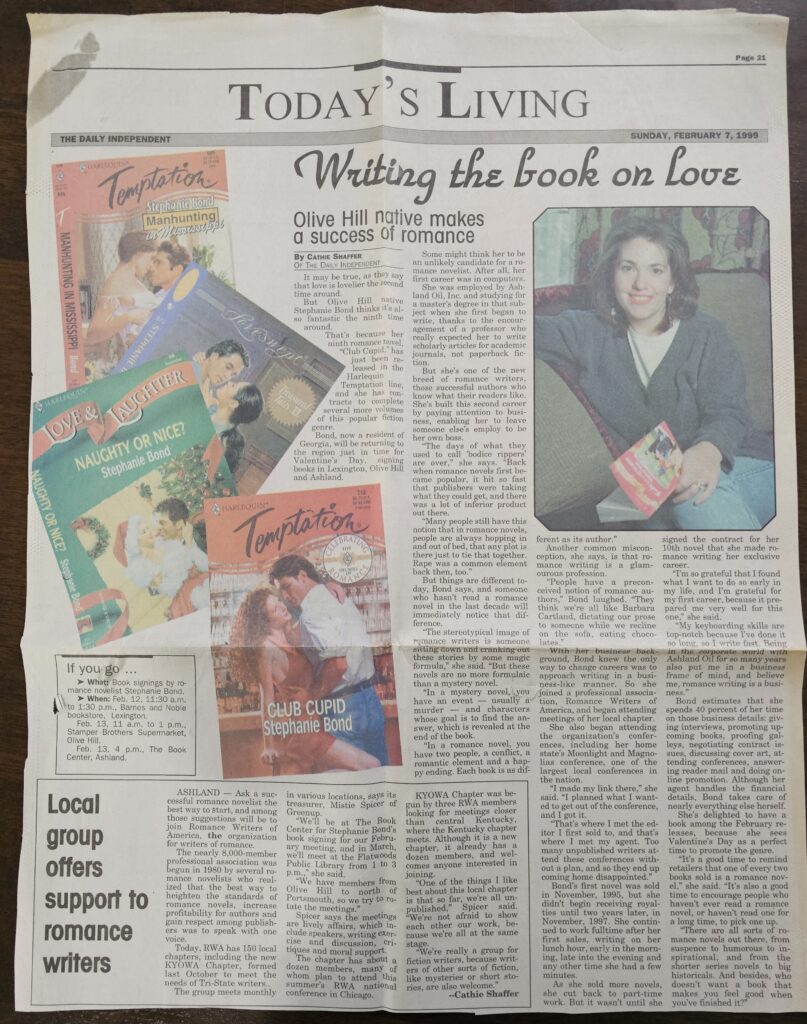
February 1999 article in The Daily Independent written by Cathie Shaffer about me and the KYOWA chapter (in the KY, OH, WV tri-state area) of romance writers.
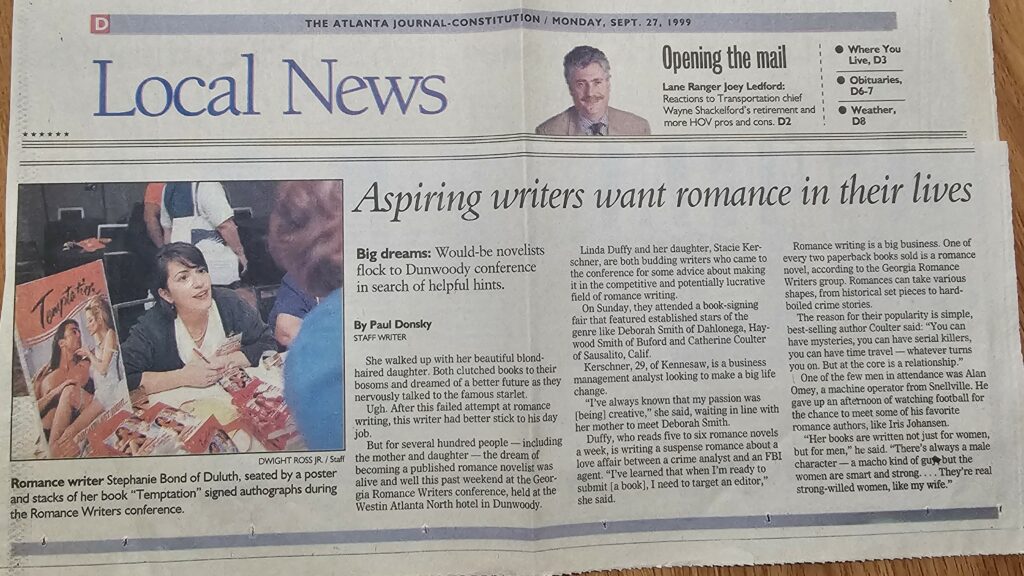
An Atlanta Journal-Constitution article written by Paul Donsky about me and other romance novelists signing our books at the 1999 Georgia Romance Writers Moonlight & Magnolias conference.
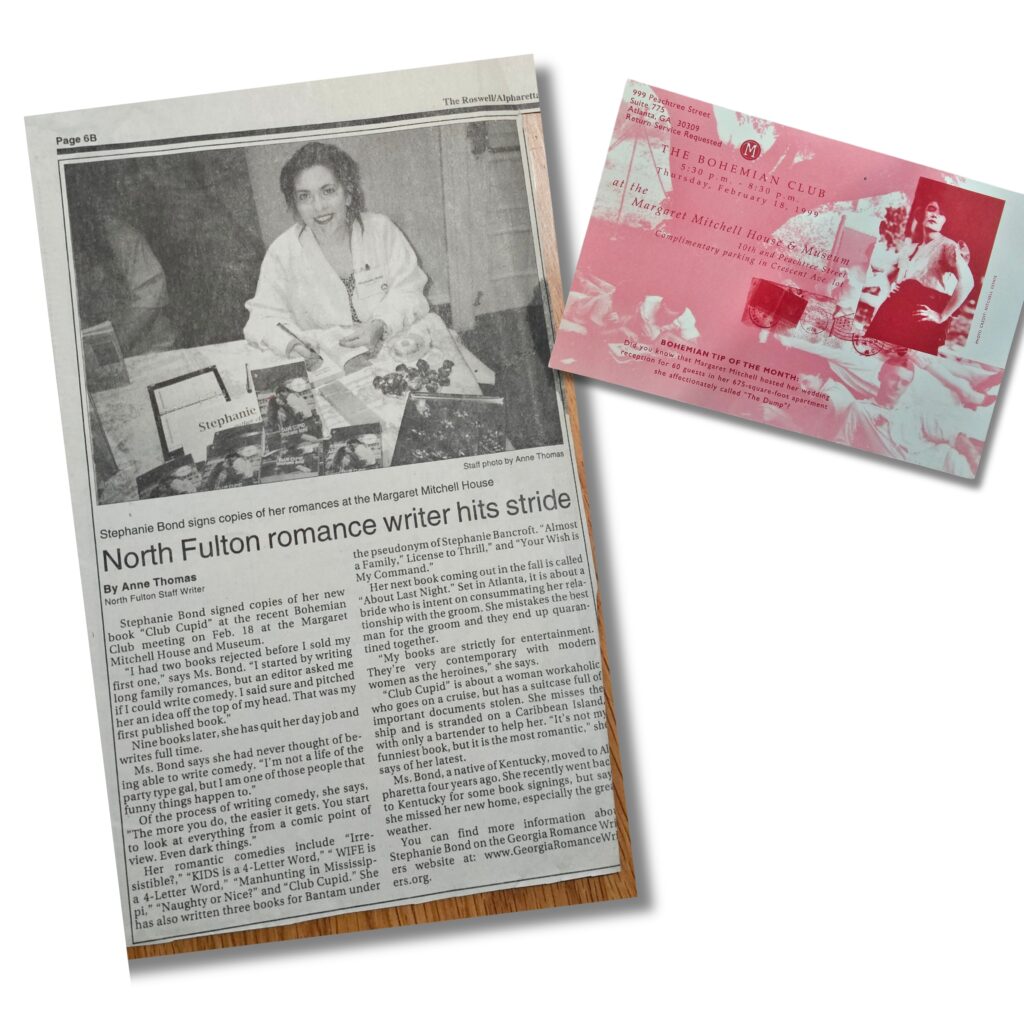
Roswell-Alpharetta Herald article written by Anne Thomas and postcard about a romance booksigning at the Margaret Mitchell House & Museum sponsored by The Bohemian Club February 1999
In About Last Night, a bride-to-be sneaks into the hotel room of her intended groom to "force the issue" of intimacy, and instead climbs into the bed of the Best Man! That's awkward enough, but then they're quarantined to the hotel room!
Back when I wrote About Last Night, the worst pandemic in recent memory was the 1976 outbreak of Legionnaire's Disease in Philadelphia, Pennsylvania, which resulted in dozens of deaths and kept the medical community guessing for weeks as to what it was and how far it might spread. But that event was over twenty-five years prior. Fast forward to now and I'd gotten the rights back to the book. Honestly, I kind of dreaded re-reading it and updating it in the wake of the Covid outbreak of 2020.
BUT to my surprise, the story of Janine Murphy and Derek Stillman who are thrown together accidentally and in the most awkward of ways, then forced to endure each other's company in the confines of a hotel room had held up pretty well! I had to update some references to technology, of course, and some cultural references. And I decided to add a couple of scenes showing how the couple get to know each other more. On top of that, this story takes place over a short period of time—days. To show the slow passage of time, I added timestamps to the chapters and scenes.
Oh, and the cover!
In the last chapter of STORIES BEHIND THE STORIES, I presented the original cover of About Last Night, which wasn't my favorite Harlequin cover:
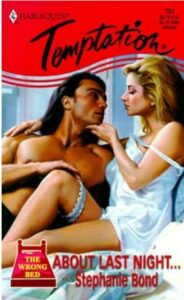
The original cover of About Last Night
And I presented two choices of updated covers that I created, and asked you to vote on the one you liked best by emailing me and by posting on my Facebook page.
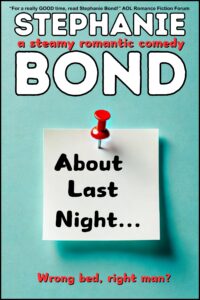
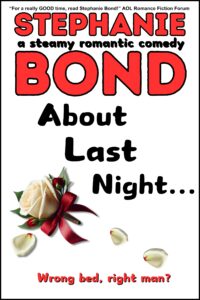
The test covers for About Last Night that had readers divided!
And guess what—half of you liked one cover and half of you liked the other cover! Seriously, the voting was 51% vs. 49%! Some of you even commented that you liked the "note" on the first cover AND the rose boutonniere on the second cover. So… I decided to combine what you liked about each cover into an entirely new image. Voila!
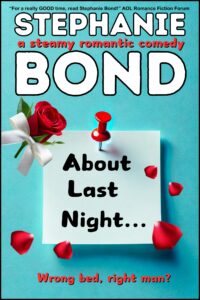
The new cover for the updated version of About Last Night—thanks to you!
The updated version of About Last Night with new packaging is available now! I hope you like it! (Available in ebook exclusively on Amazon and through Kindle Unlimited until mid-December, then it'll be available at all online bookstores. Print version coming soon!)
Back to the "story"…. at the same time my career was bumping along, I was undertaking a change in my personal life by moving from the suburbs of Atlanta to midtown. Downsizing from a spacious house to a loft condo was a long, painful process and the upheaval of a move really made a dent in my writing schedule. Getting used to a smaller, less private workspace was another adjustment. (This is a warning to writers—do not underestimate the impact of a relocation!)
But deadlines do not wait, so as the year turned to 2000 and the world didn't implode upon itself, I prepared for the release of two more projects:
First, the release of It Takes a Rebel (the sequel to About Last Night). In It Takes a Rebel, a slacker former athlete (and brother to Derek in About Last Night) has to up his game in order to impress the heiress to a family department store empire and land their ad account to save his family ad business. I got the rights back to It Takes a Rebel a few years ago, so it's already been updated.

The updated version of It Takes a Rebel (the sequel to About Last Night).
Click here to buy if you missed it! Available in ebook, print, and audio!
I generally don't have favorites among my books; that said, It Takes a Rebel is one of my personal favorites. 😊 It was so fun to write, plus it's set in Lexington, Kentucky, which holds a special place in my heart. Also, It Takes a Rebel won the Rita Award of Excellence, the highest award given in the romance industry at that time. It was a sweet moment shared with my editor and my writing friends from Georgia Romance Writers:
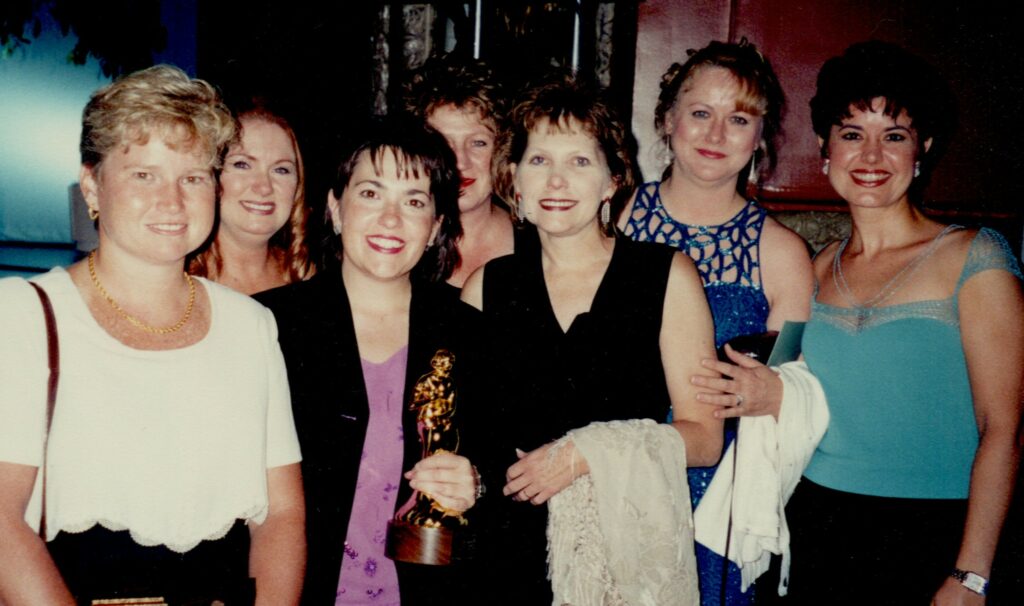
From L to R: Harlequin editor Brenda Chin, Wendy Etherington, me (holding the RITA award), Jennifer LaBrecque, Rita Herron, Jennifer St. Giles, and Jacquie D'Alessandro at the Romance Writers of America conference
The other project I was looking forward to launching in early 2000 was a first: Harlequin's very first interactive story published on their website. (Here's where I'd like to point out that Harlequin was one of the first publishers to put up a website; the idea of a huge company not having a website is unfathomable these days, but in 2000, websites were still a fledgling marketing tool and popular domain names were still up for grabs.)
I was so honored to be able to write the story titled "A Funny Thing Happened on the Way to the Wedding." The gist of how things would work was that I would write a mini-chapter that was posted on the Harlequin website. The chapter ended on a cliffhanger and for one week readers were asked to vote on the direction the story would take. The secrets results were handed over to me, and I had maybe two days to write the next mini-chapter so it could be edited and posted. A new chapter was posted every two weeks.
I have to be honest with you—I can't remember much about the premise of the story; I have a vague recollection of a bride on her way to the wedding who keeps getting waylaid by a series of mishaps… and there was something about Karma that threaded through the story. I no longer have the manuscript file, and I couldn't locate a hard copy in my files. I found a mention of it on a piracy site, but I couldn't access the site to read it!
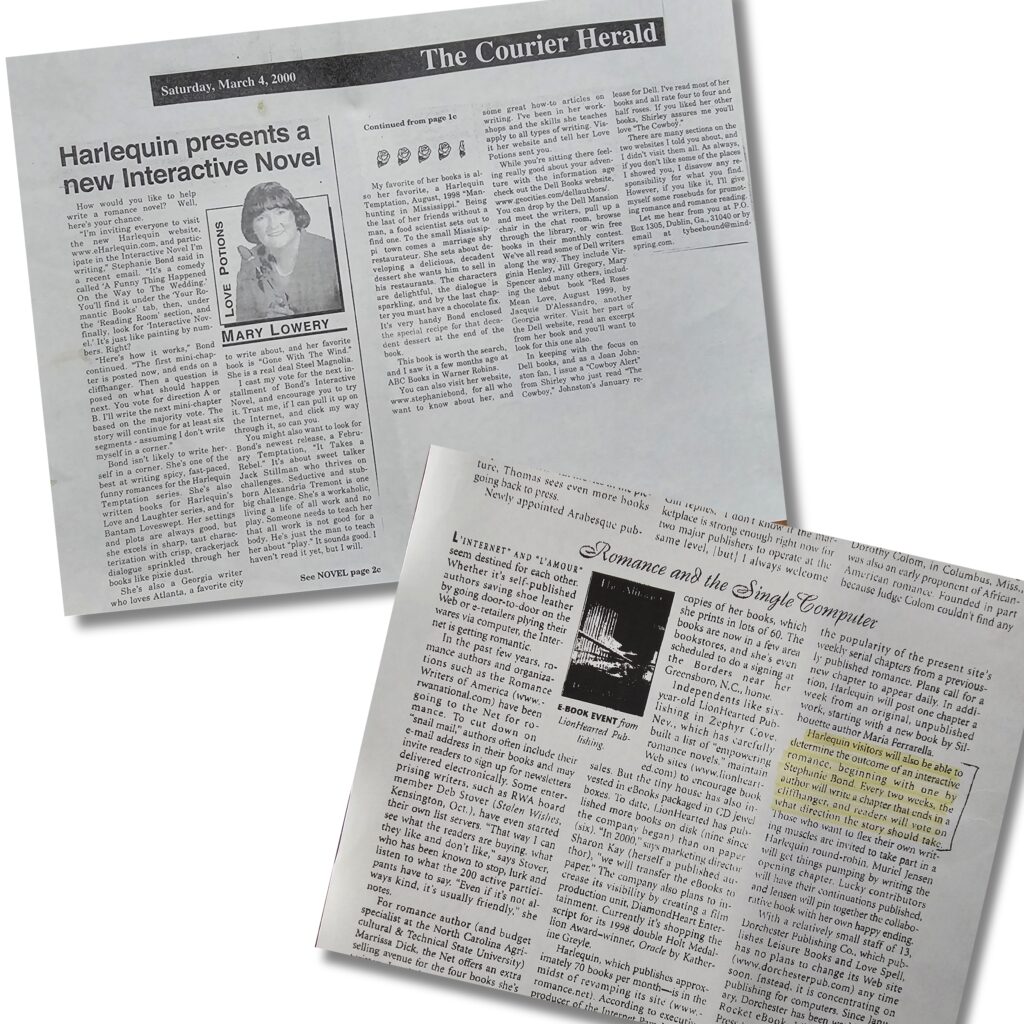
A Courier Herald article by Mary Lowery in her "Love Potions" column and a Publishers Weekly article "Romance and the Single Computer" about Harlequin's first interactive novel... written by me!
ANYWAY, the story was well received because it was such a new concept at the time. Later I would learn that a question I posed to readers asking them to post a "karma-cleansing" story led to over 40,000 postings in a bulletin board area of the site, which at that time was a stratospheric number. I'm not saying it was a brilliant question; what I'm saying is it was a very early sign to how eager readers were to interact with other readers. Harlequin was an innovator!
And for those of you who know how much I love to write serials, writing the interactive story was my first foray into serialized fiction. Writing "A Funny Thing Happened on the Way to the Wedding" would later inform my annual serials.
I'll close for now to finish some other projects I have underway. Thanks so much for following along! Next time: The book that garnered the WORST most controversial reviews of my career! ~
← (Return to Chapter 9: Steamier Romances... and a New Challenge)
A sister writer emailed a few weeks ago to say she was reading this STORIES BEHIND THE STORIES memoir and asked how on earth I remember all these things? I had to laugh because there are SO many things I’ve forgotten, which is why at times I’ll probably be going back to update these chapters.
One document I’m leaning on heavily to inform these chapters is a list I’ve maintained in a word processing file from the beginning of my career that I’ve titled Body of Work. In this file I list all my published works chronologically, along with the editor’s name, the publisher, the original ISBN (International Standard Book Number), the genre, and pertinent information like subsidiary rights sold, any special reviews or awards the book received, and any reprints.
I remember sharing with my critique partners when I first created the document after my first couple of books were released. I felt a little silly because at the time it seemed incomprehensible that I could forget a single detail about any of my published books. But I was also aware how quickly things were moving—it was common to be working on three books at one time that were in different stages of completion, and I was always thinking ahead to future projects I could pitch. When I received author copies of my newly released books, they would seem distant in my mind because I’d written two or three other projects by then. Two romance lines I’d written for had already announced they were closing. I’d barely gotten my writing career off the ground, and I was starting to feel like a veteran in the industry. And because I planned to write many books in my career, I had a suspicion that documenting my releases would be beneficial in the future.
Spoiler alert: The document grew from one page to now more than twenty-one pages, and I can’t count the times I referred back to it to answer questions for my editors, agents, reporters, but mostly for myself! In fact, as I write this, my Body of Work document is open in another window for me to refer to.
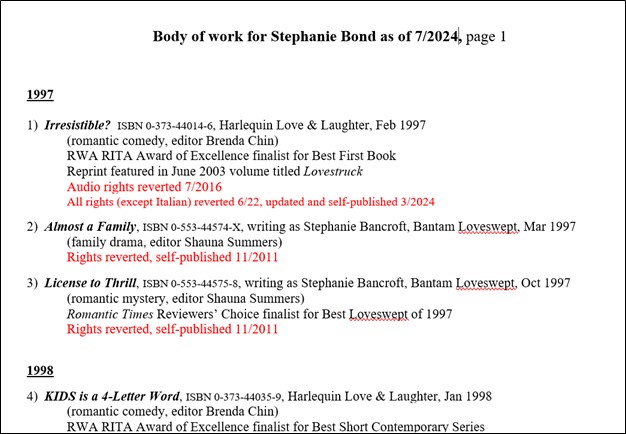
A snippet from page 1 of my Body of Work document
Another good use of the Body of Work document is for my heirs to refer to in order to trace the history of each of my titles as they were published, as some rights were reverted to me, and the books were republished under my own self-published imprint. Because as attentive as my family members have been over the years, let’s face it—after a while, the titles and covers begin to blur. Toss in occasional title changes and different versions of covers and even I can get confused! So if you’re a creative entrepreneur, I encourage you to document your products. Not only is it a smart thing to do for your business portfolio, but reviewing your body of work is a great mood-booster if you find yourself in a creative lull.
Back to my writing career. When I left off, I was waiting to hear if my humorous romantic mystery Our Husband, about three women who learn they’re married to the same man, would find any takers among New York publishers. I was a nervous wreck because it would mean a big leap in my career from writing category romance to writing single title books. After a long period of feedback during which I massaged my idea until it was unrecognizable, then back again, my agent called to let me know that… wait for it… more than one editor was interested!
In fact, two editors were willing to make offers.
My agent and I discussed the offers. You might think that an author automatically takes the offer with the highest advance, and it’s true that the advance money is all an author can really count on.
Sidebar: A book advance is just that—an advance on future earnings. Generally a publisher will offer an advance that reflects what they believe an author will earn in royalties in a certain amount of time, and every publisher has their own timeline. I should note here, though, that if an author doesn’t earn back their advance, they don’t have to pay back the difference. Also, if an author doesn’t earn back their advance (referred to as a book “earning out”), the publisher can still earn a boatload of profit on that book. I’m venting here because I’ve heard too many times that authors were let go from a publisher because their book didn’t earn out. When an author’s book doesn’t earn out, all it means is the publisher shared more of the profits with the author than they intended! And while it’s true that not every book earns the publisher a profit, profits are more prevalent today because selling ebooks has very little overhead, and print books are typically printed in small quantities on-demand. I’m not saying that publishers are making more overall than they did ten or twenty years ago… I contend it's easier for each title to turn a (small) profit today than it was back when a large print run and high returns could crater a book’s profit margin. Also, when I say an ebook has “very little overhead,” I mean for that individual title. The primary overhead for a publisher is in its experienced staff—editorial, sales, marketing, distribution, etc., but those overhead costs are spread over all books the publisher releases.
But back to my offer. Yes, a higher advance is attractive, no doubt. And my belief has always been the more a publisher invests in an advance, the more they’re forced to up their sales and marketing game to recover their investment. But there are other elements of an offer to consider—where the book will be placed in the publisher’s lineup, the planned format(s) of the book (hardcover, oversized paperback, mass market paperback, ebook), the print run, the anticipated cover price, the release date(s), the proposed marketing plan, creative control (will the author have cover approval?), what rights are being purchased (foreign language? Audio?), and other factors such as is this a one-book offer, or is the publisher willing to invest in the author’s future by offering a 2- or 3-book contract? And more esoteric elements such as whether the editor making the offer has a track record of growing their authors’ careers.
All that said, I had a difficult decision to make—one editor, Stephanie Kip at Bantam, was someone I’d worked with before and liked very much. Plus I was grateful to Stephanie for giving feedback that got the project back on track. The other editor was Jennifer Enderlin at St. Martin’s Press, whom I knew only by good reputation. My agent and I discussed the offers carefully and in the end, we both decided the package being offered by St. Martin’s was more attractive in terms of launching my single title career. My agent made the call to accept the offer, and I was walking on air!
But meanwhile, I had projects in the pipeline at Harlequin—and I wanted to continue writing for them. And while it might seem as if me selling to a competitor would create conflict, it was in Harlequin’s long-term best interests if another publisher put out my books in a bigger way to a larger audience so those readers would cross over to read my Harlequin books. Because the book I’d sold to St. Martin’s Press wasn’t a “category romance” that would compete with my category romances with Harlequin, I was free to use my name, Stephanie Bond.
The pen name of Stephanie Bancroft I’d used for Bantam Loveswept was officially retired.
And suddenly I was busier than I thought possible. I was writing projects for Harlequin at the same time I was writing Our Husband, a book that was more than twice as long as my Harlequin manuscripts. And because there were fewer slots for single title books to be released each month, it would be a while before Our Husband would be published. In fact, I would release five more Harlequin titles before Our Husband hit the stands.
Next up for Harlequin was a book called About Last Night. My editor had asked me to come up with an idea that would fit in the Harlequin Temptation mini-series “The Wrong Bed.” Every story in the mini-series would feature a story in which—you guessed it—someone in the story ends up in the wrong bed.
A word here about constraints. Creative constraints are when you’re handed some part of the concept and asked to put your own spin on it. Previously I mentioned my sophomore English teacher read the beginning of a story and asked the class to write their own ending. That’s a constraint. I actually prefer constraints because it gives me something to springboard from. Because there were already several “The Wrong Bed” books published, I skimmed them to get the gist of the premise so I wouldn’t inadvertently repeat something that had already been done. Here’s what I came up with:
A bride-to-be who’s worried because her groom hasn’t wanted to consummate their relationship decides to slip into his room at the hotel where he’s having a bachelor party and, ahem, force the issue. Except she winds up crawling in bed with the Best Man! And before they can right the situation, the hotel is placed under quarantine because a mysterious contagious illness breaks out and they’re forced to stay in the room together.
(This was 1998—twenty-two years before Covid-19 would change how the world perceived contagion in public places and forced proximity.)
My editor loved it, so I set about writing the first few chapters. I felt that the heroine Janine needed a confidante, someone who would encourage her to do something that was out of character for her but with her best interests in mind. So I gave her a sassy sister. The sister was great—she gave my heroine the nudge she needed to pull off the stunt. And as the hotel fell under quarantine, her sister was the person on the phone who helped her get through it.
Then my editor called. The publisher was still receiving letters from readers who wanted more of my character Manny Oliver, who had to this point appeared in my first book, Irresistible?, in Wife is a 4-Letter Word, and Naughty or Nice? Could I please include Manny is this book, too?
Well, the first two books Manny appeared in were in Atlanta; in the third book he moved to San Francisco to work in a hotel. This book was set in Atlanta and in a hotel, so theoretically I could have him move back and stay in the hospitality industry. I agreed to add Manny to the plot and I backtracked to weave him into the story.
But suddenly Janine was confiding in her sister AND in Manny. I realized entire conversations were repeated as Janine shared with each of them what was happening in the hotel room where she and the Best Man (Derek) were confined. So I scaled the sister waaaaay back and give the role of confidante to Manny. It was a good writing lesson for me to learn and I knew I was getting better because I realized what was wrong before my editor had to point it out.
By this time, I’d also happened upon a workflow that would change the way I wrote for my Harlequin editor Brenda Chin. The way we worked was typical—I would sell a story with a long synopsis that described the characters and how the story began, progressed, and ended. Once Brenda approved the story I would write the entire manuscript and send it in by the deadline. She would read it as her schedule allowed and create a revision letter with “big picture” things to change as well as specific changes on pages throughout the manuscript. She would return the marked up and flagged manuscript with the revision letter and I would make the changes, print a revised manuscript and send it back to her. With the first few books, there were at least two rounds of changes, which took a loooooooong time, and the logistics of mailing the full manuscripts back and forth was clunky.
I also noticed that if there were “big picture” problems, they generally occurred in the first few chapters of the manuscript, which would snowball into more and more changes as the story unfolded in a direction that wasn’t what Brenda had in mind. So I suggested that I write the first several chapters and send them to her to review, then she would read and send me back revisions on those pages. I would make changes she wanted, then keep going. Then I would send her another chunk of chapters with a “Here’s what happened up til now” summary to remind her of the plot details. Then she would read the second chunk and send me revision notes on THOSE chapters, and so on. That meant that usually when I typed “The End” the story was in pretty good shape because I’d made changes all along. It sped up the editing process dramatically because it was easier for her to make time in her day to read a few chapters rather than an entire manuscript. This “edit-as-we-go” workflow was instrumental in me being able to write multiple manuscripts for Harlequin in a year’s time.
I was happy with the story I’d written for About Last Night, and that I’d figured out a way to plot a connected book (the hero’s brother) to write later. But when the cover proof arrived, I confess I wasn’t thrilled. Neither character looked like the characters in my book, although I conceded it had a sexy vibe. Note the icon denoting the book as belonging in “The Wrong Bed” mini-series. And it sold just fine—Romantic Times Book Reviews (click on the link to read more about this wonderful magazine that uplifted the romance genre) gave it a good review, saying it had “an unusual plotline.” Unusual plotline—hold that thought!

Original cover for About Last Night... These people are pretty but they look nothing like my characters!
And in between writing, writing, writing, I was still setting up booksignings when and where I could. Here’s a piece from my hometown paper, Olive Hill Times, announcing a signing at the local grocery that carried my books at their meat counter! 😊 In the article I gave the following advice for aspiring writers that I still stand by:
“Write. Don’t dream about writing, write. Every novel starts with a sentence.”
So true!
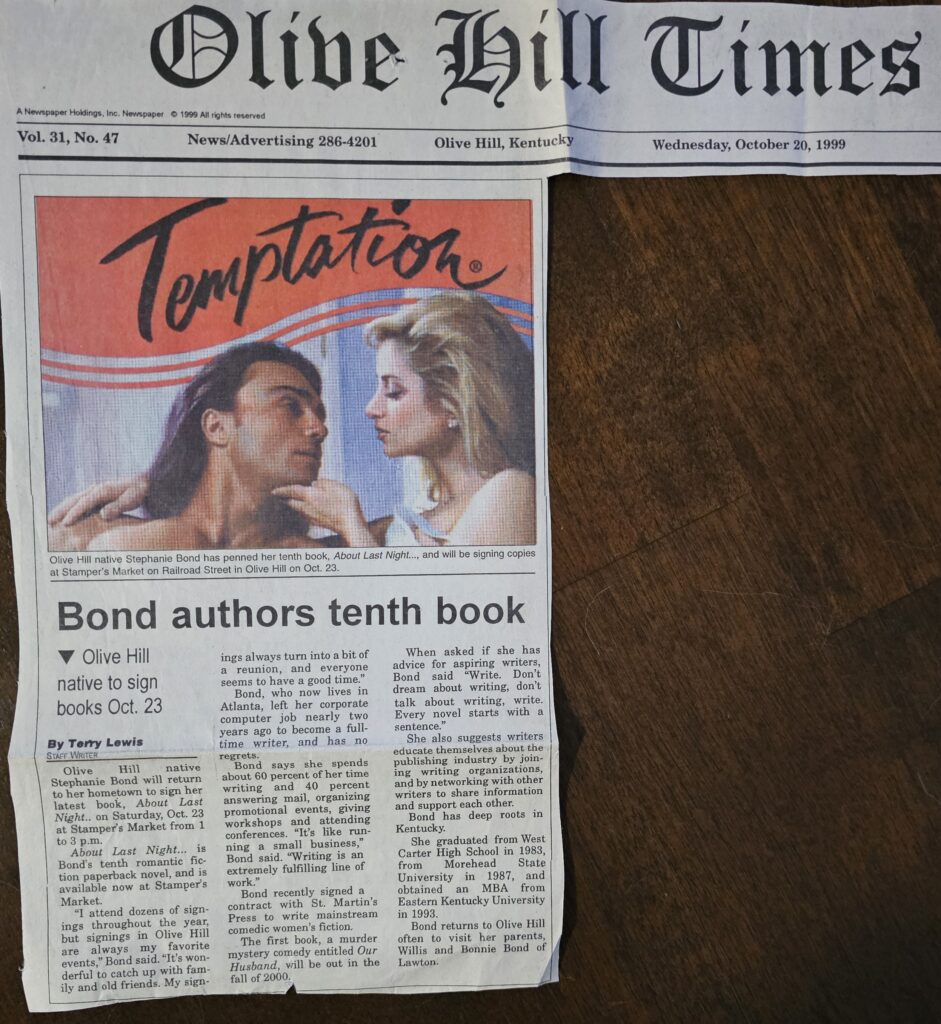
Announcement of a booksigning at my hometown grocery store... the full original cover of About Last Night was a little too racy for the front page of the Olive Hill Times. :- )
Harlequin recently reverted the rights to About Last Night back to me, so I’m in the process of updating the book. Ugh, what was “an unusual plotline” when it was released in 1999 is not so unusual (or sexy) in 2024, post-Covid, so I have my work cut out for me!
Plus I need a new cover—and your help! I’ve designed a couple I like, but I’d really love your feedback to get it just right before I put up a pre-order for the updated version of About Last Night. Here are the covers I came up with:


Will you email me at stephanie@stephaniebond.com to let me know which one you like? I’ll also post this on my Facebook page and ask for comments there. (Note--the voting has ended! See the next chapter for the resulting cover!)
Next up in STORIES BEHIND THE STORIES: My decision about the cover for About Last Night based on your feedback! Also, how I wrote Harlequin’s first ever interactive story for their website! ~
←Return to Chapter 8: Pivoting to New Romance Lines
Thanks for coming back to my STORIES BEHIND THE STORIES project. I'll keep posting chapters as my schedule allows. The reality of a creative vocation is that sometimes, deadlines converge and there simply aren’t enough hours in the day to meet all my commitments. I really appreciate your patience as I continue down memory lane...
And while I’m on the subject of a creative vocation, I’d like to answer some questions I received after my remarks in Chapter 7: I Got This (I Think) regarding advice to anyone who’s considering making the leap from a job they don’t enjoy to something more creative. The most common question I received is How to encourage children and grandchildren who have stars in their eyes to follow their dreams but to also have a backup plan? And how does a person know if their child/grandchild has what it takes to become a professional writer/actor/musician/artist/dancer, etc.?
That’s a good question because we’re all guilty of over-praising the people we love. Their creative endeavors are so special to us, it’s a short jump to assuming the public will feel the same. So how do you find the balance of being supportive and realistic? My advice is to encourage the person to learn as much as they can about their chosen profession before they commit. If they want to be an artist, was that decision made after one watercolor painting night class? Did they decide to become a writer after reading one book that resonated with them? Did they decide to become an actor because their high school drama teacher praised them in a stage performance?
There’s a general sense that people who are successful in creative fields were born with innate talent and didn’t have to study or intern or labor in obscurity in order to have that success. And sure, there are anecdotes about people who achieved huge success on their first attempt, but if you drill down into those stories, there’s usually a certain amount of luck involved, or the person had contacts who lubricated the process for them.
So I suggest you urge your loved one to take many classes and get a job or volunteer in some part of their chosen industry to learn the ropes. If they’re reluctant to put in true effort and sacrifice, that’s a red flag they don’t want it enough to weather the ups and downs. And that’s okay—maybe they’ll revisit their creative interest at another time in their life.
Another question I received was what happens if your partner doesn’t support your dreams to move into a creative career? Oof, that’s a hard one. First, be honest with yourself—if you’ve dabbled in different creative pursuits in the past and lost interest, it’s understandable that a partner would be skeptical this time around. I would say first, have an honest conversation with your partner about how much this means to you, and be prepared with a plan about how you’re going to make it happen, step by step. Having a partner who doesn’t support your efforts or is resentful of the time you spend on it or is jealous of the attention and money you receive from it will lead to constant conflict. Be prepared for the dynamics in your relationship to change as time, attention, and money flow in and out of your creative vocation. That said, you and your partner are both entitled to change and grow, and to expect the other person to be supportive, as long as it doesn’t create an undue burden for others or threaten the family finances. Relationships are supposed to go in two directions!
And the third most common question I received from readers who are itching to ditch their “day” job for something more creative was simply, how do I get started? It’s true that for most careers, there’s a set path to follow: college, perhaps post-graduate work, then working with a college recruiter or interviewing to land an entry-level job, then progressing through the organization or moving to other companies within your industry to climb the ladder. But in creative fields, there’s no single entry point, no obvious path of progression, and fewer clues to know when you’ve achieved “success.” It can be intimidating, for sure, and, as one of my writing friends put it, “is not for sissies.”
Referring back to my previous post, the most safe and sure way to get started is by taking baby steps. Sign up for a class. Subscribe to a podcast. Buy a how-to book. Join a professional organization or a local Meetup group. (For writers, Romance Writers of America, Sisters in Crime, Society of Children's Book Writers and Illustrators, and International Thriller Writers accept aspiring writers, while other organizations like Novelists, Inc. and Science Fiction and Fantasy Writers have minimum publication requirements.) Identify someone who has the career you’d like to emulate, then sign up for their mailing list and pay attention to their backstory, their process, their product, their marketing, and their general sense of wellbeing and happiness. We’ve all heard stories about people who are at the top of their field and, according to social media, are “killing it.” Then we learn later they completely burned out and imploded spectacularly. Creative endeavors, as my friends and I are constantly reminding each other, are supposed to enrich our lives, not bleed us dry. Just make sure the person(s) you choose to emulate has enough history to prove their staying power. You should be in it for the long haul.
Also, I encourage you to write down your goals and give yourself deadlines for achieving them. A journal can be invaluable to document the highs and lows… or you might document your path on a blog, or on social media or through videos. Going public with your dreams is a big step, but it can be a huge source of inspiration. And of course, I’ll keep reiterating that nothing will move you forward faster than finding others who are pursuing the same goal and linking arms to learn together. This week alone I was in touch with four writers I’ve known for over 25 years, and we all agreed it’s impossible for other people to understand what we experienced in our careers. We’ll be bonded for life.
Okay, back to my writing career…
It was 1999 and I was preparing for the release of my next Harlequin Temptation romance novel. I’d pitched a story about a female workaholic who grudgingly agrees to go on a wedding cruise as a bridesmaid, then gets stranded at a cruise stop when she misses the boat. My original title was Stranded in Paradise, but editorial came back with a more “sexy” title: Club Cupid, a twist on Club Med, which used to be a wildly popular brand for all-inclusive exotic vacations (and still exists). Also, the book was given a February release slot, so the word “cupid” let readers know it was a Valentine’s Day story.
In Club Cupid, workaholic Frankie Jenson is stranded from her cousin’s wedding cruise in Key West after her laptop is stolen. Until she can be reunited with the cruise, she’s forced to rely on a Good Samaritan in the form of a sexy bartender. She falls hard for the man who’s the opposite of her in every way, but this can’t end well… can it?
Because this book was sold in the Temptation line, I had to find ways to make it super sexy—lots of sun, skin, and provocative situations!
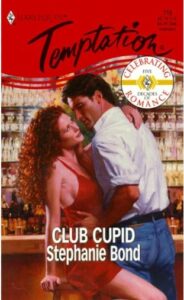
Original cover of Club Cupid… LOVED!
I thought you might get a kick out of seeing some of my booksigning events from that era:
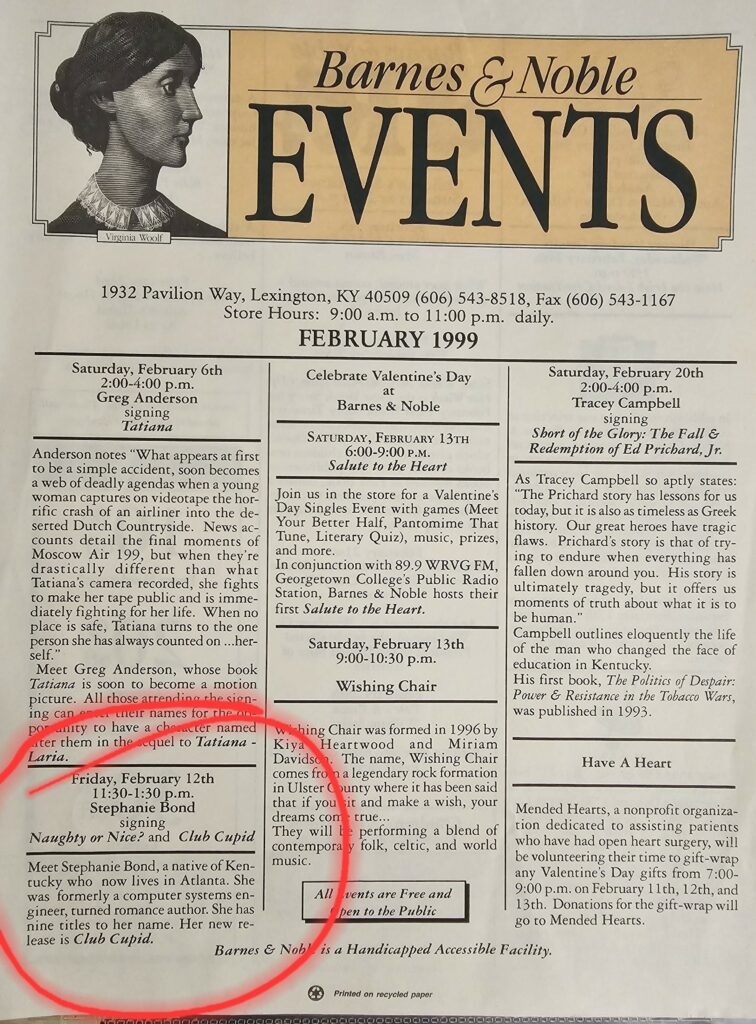
This Barnes & Noble store in Lexington, KY at the Hamburg Pavilion is still there, and is still a terrific store.

Another signing at Stamper Bros supermarket in my hometown of Olive Hill, KY. 😊 This piece appeared in the Olive Hill Times, February 1999, written by Sharon Hall.
And I was lucky enough to score some coverage in Kentucky Monthly magazine:
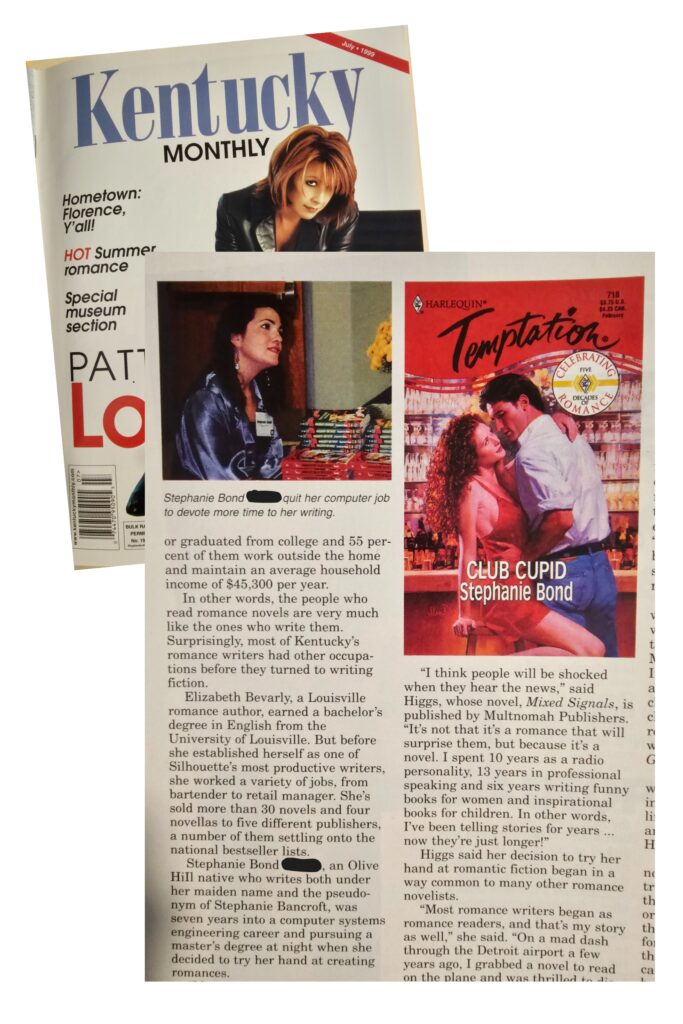
The article titled Hot Summer Romance was written by C.M. Eicher and featured romance authors with a connection to Kentucky including Teresa Medeiros, Elizabeth Bevarly, me, Liz Curtis Higgs, Annie Jones and Patricia Rice. (Btw, that’s Kentucky country singer Patty Loveless on the cover—HUGE fan! It’s impossible to listen to her hit “How Do I Help You Say Goodbye?” and not cry.)
ANYWAY, a couple of years ago, Harlequin reverted the rights to Club Cupid, giving me the chance to update the manuscript, and gosh, it was a lot of work, mostly because of technology. In the original manuscript, the heroine is talking on a pay phone when her computer bag is stolen, along with the only copy of an important work plan. And there were enough limits back then that it seemed realistic she couldn’t reach out to the cruise line, her relatives, and even her coworkers. But bringing the story into modern times meant working around a LOT of technological advances and creating new ways to prevent Frankie from making contact with people she would normally rely on. After I updated the manuscript, I put a new cover on it!
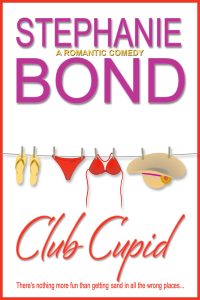
In case you missed it or would like to read the updated version, here's a link to Club Cupid.
At the same time I was promoting Club Cupid, my agent and I were discussing what to do to make up for the slack in my schedule created by the closing of the Bantam Loveswept line. I shared with her my desire to write a “single title” book, meaning a book that wouldn’t fit or be released in a set “line” at a publisher, like the category romance lines at Harlequin. All of the romance publishers bought and published single title books, but the competition was keen. My agent asked me to submit a list of ideas that would be “big” enough to sustain a longer book. I submitted the list of titles and the corresponding stories in the form of a few sentences. My agent kept coming back to one idea I called Our Husband about a woman who learns her husband is a bigamist with two other wives. When the magnanimous hubby dies suddenly and suspiciously, the wives have to team up to prove their innocence. In my mind, it would be a mystery, with the main character (the middle wife) possibly getting a new romance. Because making the jump from category romance to single title was a big career move, my agent asked me to write a long synopsis so she could pass it around the agency to get feedback. I did, then sent it to her and kept working on other projects.
The feedback was slow and um, conflicting. Someone suggested the women needed a reason to work together other than their husband’s murder. Someone else suggested that the husband not be murdered, but go to jail for some reason and leave a business for the women to be forced to run together until he got out. And then there was the matter of what kind of business—an advertising firm? A hotel? A department store?
After many months of back and forth and countless iterations of the synopsis, someone suggested the company be a women’s underwear business. I rewrote the synopsis yet again, and I gotta tell you, I was starting to lose my enthusiasm for the story. Every version became longer and more convoluted. I appreciated the people who gave me feedback, but my original concept was gone and getting muddy.
Side note: You know a story is too muddy when it’s difficult to write the back cover blurb. When you have to supply detail in order to describe the idea, it’s not high concept enough.
My agent decided to submit the synopsis to an editor we trusted and hoped to work with—Stephanie Kip, my former editor at Bantam. Stephanie kindly read it and while she liked the overall concept, asked why the story was so complicated? My agent ruefully suggested that we go back to my original idea and submitted that version to Stephanie. Yes, she said, now she could see the story, and it might be something she’d be interested in buying. Let me add here that it's easy to think I wasted time exploring those other angles, but now I was more confident in my original idea and if anyone brought up other tangential ideas, I was prepared to defend my concept, so it was a worthwhile, if time-consuming, exercise.
So now we had the kernel of something that could be a longer, more layered story. My agent suggested that I expand on my original idea with character sketches of the husband and the three wives. I wanted to maintain a humorous tone, so I gave the husband a quirky job—he sold prosthetic limbs. And I made the three wives wildly different—a socialite, a physician, and a stripper. I wrote a prologue showing the husband suffering an event that landed him in the hospital, and the first couple of chapters showing the middle wife going to the hospital and learning about her husband’s betrayal because his other two wives also show up.
We kept the title of Our Husband, and submitted the proposal “wide,” meaning to several editors at different publishers at once. And we waited.
Have I mentioned how much time a writer spends waiting? Waiting for yes, waiting for no, waiting for "maybe, if you change this and that." Usually a yes is fast and a no is slow, but not always. The more money that’s at stake, the more people who have to weigh in on a decision. Plus when single title books are considered, they have to fit into an overall publishing brand, meaning the book has to be unique and able to stand on its own, yet still be something that would appeal to a publisher’s existing audience. And then there’s the author—are they someone the publisher is willing to invest in long-term and possibly take resources from an author they previously invested in?
I was hopeful for at least one “YES” but prepared for unanimous “NOs.” I was a nervous wreck—I didn’t want to disappoint my agent or be embarrassed in front of my family and friends who had cheered me on throughout the entire process. I was afraid to leave the house because I might miss a call (this was back when we only had landlines).
And finally, after weeks and weeks and weeks of waiting, my agent called with news. ~
←Return to Chapter 7: I Got This (I Think):
It was mid-1998 and I was starting to get into a good groove of selling romance manuscripts to Harlequin Love & Laughter and to Bantam Loveswept. My Harlequin editor Brenda Chin had also asked me to pitch a story for another line she edited, the Harlequin Temptation line. That was an exciting promotion for me because the line was more successful. I was writing and delivering manuscripts while doing staggered revisions and line edits and copyedits and cover art forms and a dozen other sets of tasks required for the lifecycle of a romance novel. I absolutely loved it, but between my demanding new career and my personal commitments, it felt as if I never had a free moment. Writing is like that—you can feel as if you should always be working on a story.
One thing that kept me sane was meeting every week with my critique group, writers I'd met through Georgia Romance Writers. We would meet on a weekday evening at a restaurant that was central to all of us. We spent the first few minutes catching up and sharing news. Then we ordered our meals, and while we waited for our food, we would focus on one person's pages that we'd taken home the week before to read and write comments directly on the pages. We took turns going through the pages and giving our critiques, asking questions, and doling out advice to fix problems. While we ate and afterward, we'd finish everyone's critique. Sometimes members would bring a one-page idea, sometimes members would bring 20 pages. Sometimes we agreed on how to improve a story, sometimes we didn't, and it was always up to the writer being critiqued as to whether to take members' advice. We were all at different stages of our careers—half of the group members were published with active contracts, and the rest of the members were actively writing and submitting ideas to various publishers. We were all invested in each other's success and cheered each other on. We celebrated good news and commiserated over bad news.
All of us were writing romance, but in different subgenres (with different audiences): romantic comedy, romantic suspense, paranormal romance, sweet romance, multi-cultural and African American romance. You might think that would make it harder to critique each other, but it allowed us to read each other's pages as a reader, and not someone who also wrote that type of romance. And critiquing someone else's pages is the surest way to improve your own writing—it's much easier to see mistakes someone else is making, then realize you're making the same mistakes! In my experience, the success of a writing critique group has less to do with all the members writing in similar genres, and more to do with everyone having the same level of commitment and ambition.
Once a month I attended the Georgia Romance Writers meeting. Now that I was published, I was eligible to belong to the Published Author Network, which was a subgroup that focused on the particular challenges of authors that were under contract, such as dealing with agents and paperwork, the care and feeding of editors :- ), plus marketing and advertising. The conventional saying was that unpublished authors believed their problems would be solved when they sold their first book, when in reality, a newly published author simply traded one set of problems for another. Granted, though, it was a set of problems most of us preferred!
Speaking of problems… a few months prior my editor at Bantam Loveswept had left the industry and I was assigned a new editor, Stephanie Kip, whom I loved working for as much as the first editor. Stephanie edited my third Loveswept, Three Wishes, and I was looking forward to working on many more projects with her, including the fourth project I'd just sold her about a young woman in a coma in a hospital bed, and the young man who'd caused the accident who'd put her there. But sadly, Stephanie called to let me know that after 16 years the Bantam Loveswept line, which had spawned the careers of many mega-authors, would be ending the following year. (Click on this link to read more about the history of the Bantam Loveswept line and some of the famous authors who wrote for it, plus details about the later resurgence of the line in ebook-only format.) When I asked what would happen with my coma story, Stephanie explained the editorial board had decided for all books that had been contracted but not yet delivered, the contracts would be cancelled, and the author could keep the advance already paid (a generous gesture, I should point out). She and I were both sad our time together at Loveswept was over, but I was hopeful I might work with her again someday. Careers, after all, are long.
As promised, I received a letter from Bantam canceling my contract for the coma book and reverting all rights back to me. My agent Ruth Kagle then suggested that we request rights reversion for the three books of mine that were published under the name Stephanie Bancroft. I remember at the time asking her what on earth would I do with them if I got them back? She said it didn't matter if I had plans for them or not, that it would be better if the rights were in my hands rather than someone else's. (Years later when the self-publishing industry exploded, I would realize just what a visionary Ruth was.)
So we requested the rights back. I should say here that like most publishers, Bantam recognized the value in sitting on early books and re-releasing them when authors made a name for themselves, but since I'd written the 3 books under a name different than the name I wrote under for Harlequin, even if I went on to be a mega-star at Harlequin, Bantam wouldn't be able to capitalize on that name. In short—the 3 books I'd written for them as Stephanie Bancroft had little to no future value as far as Bantam was concerned. They granted our reversion request for Almost a Family, License to Thrill, and Your Wish is My Command (later retitled to Three Wishes), which I tucked away in my files and honestly, kind of forgot about.
I couldn't mourn the loss of Loveswept for long. My first book for the Harlequin Temptation line was released in June 1998. The Temptation line featured stories that were less comedic and more, um, tempting, meaning I had to ratchet up the intimacy in this story… and I did! The book was part of a "manhunting" mini-series written by different authors. I had the idea of a woman embarking on a manhunt in an impossibly tiny town. My original title was Manhunting in Mudville… but it was decided (and I agreed) that it would have more appeal to international markets if the title contained the name of a state instead of a made-up place, so it was changed to Manhunting in Mississippi. The heroine is a food scientist who works in a kitchen lab designing desserts for restaurants who decides to embark on a manhunt, armed with her grandmother's Guide to Marriageable Men. The hero is a restaurateur who comes to the small town on business and to contemplate his girlfriend's marriage proposal. In the story I utilized the food and desserts in some interesting ways. This is a steamy romantic comedy!
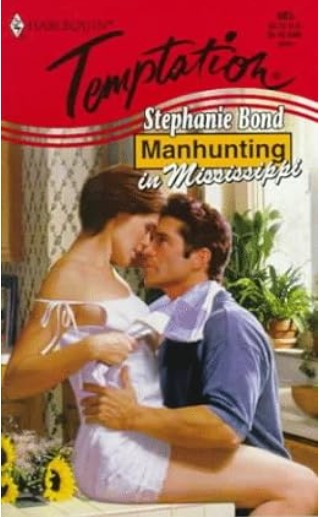
The original cover of Manhunting in Mississippi, released by Harlequin in June 1998 (I loved this cover!)
A few years ago, Harlequin reverted the rights to me, giving me a chance to update the story… and wow, it needed it! This is a workplace romance and social sentiment on workplace romances have changed drastically (and rightfully so) over the years. I was thrilled to be able to bring the story forward with a modern sensibility… and a new cover, which I also adore!
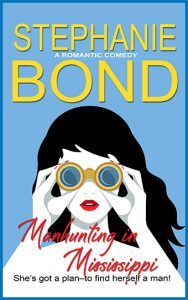
Updated version of Manhunting in Mississippi, in case you missed it!
Then I got a call from my Harlequin editor Brenda Chin. Unfortunately, the Love & Laughter line wasn't selling as well as hoped and the line would also be ending the following year. I still had one more book in the line coming out, but because she'd already invited me to write for the Temptation line, she said it only made sense that I would continue to write for Temptation. In hindsight, I wonder if she suspected the Love & Laughter line wouldn't last and invited me to write for Temptation as a safety net. Regardless, I was grateful. And I was reeling over how quickly entire romance lines could disappear. The authors impacted had to pivot, or risk disappearing along with the lines. Some were so devastated, they never wrote another book. But I was already determined that someday, my name would mean more to readers than the "line" I was writing for.
Until that day however 😊, I was gearing up for the release of my final book in the Harlequin Love & Laughter line, a holiday romantic comedy called Naughty or Nice? In Naughty or Nice? the female director of a boutique hotel in San Francisco is facing all kinds of issues, including the possibility of closure if the inspector who's supposed to arrive after the holidays finds the property isn't up to snuff. She's so stressed out, she does something completely out of character by indulging in a holiday fling with a guest. But the guest isn't quite what he seems!
When I pitched the idea to my editor, she immediately saw the comic potential of a holiday romcom set in a hotel and she bought the idea based on a synopsis, which is a three-five page description of the story. (A big thanks to my brother Jamie for providing details and anecdotes about the running of a hotel—he's worked in the hospitality industry his entire adult life.)
After my editor okayed the synopsis for Naughty or Nice? I was a few chapters into the manuscript when my editor called with an interesting request. Unbeknownst to me, Harlequin had received a lot of positive feedback from readers regarding my character Manny Oliver who was featured in my first book Irresistible? and also in Wife is a 4-Letter Word. She asked if there was any way I could include Manny in Naughty or Nice? I thought about it—it would take some maneuvering considering the other titles were set in Atlanta and Naughty or Nice? was set in San Francisco… but I decided to let Manny relocate to the West Coast to start a career in the hotel business, and I think he was a great addition to that book as a sympathetic colleague to the heroine Piper and an inadvertent relationship advisor to the hero Eric.
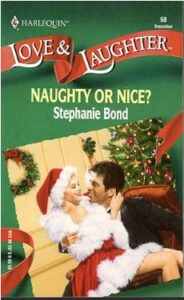
Original cover of Naughty or Nice? first published December 1998.
Naughty or Nice? was re-released in various formats over the years many, many times, but a few years ago, Harlequin reverted the rights to me, and I updated the story for re-release… with a new cover! The story is set at Christmas, but if you missed it or would like to read the updated version, I hope it'll put a smile on your face no matter what season it is and no matter how you celebrate the gift-giving holiday.
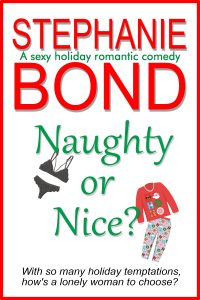
Naughty or Nice? updated story and cover!
The task of promoting my books was ongoing! This is me at a mass booksigning at the Moonlight & Magnolias writers conference, October 1998.
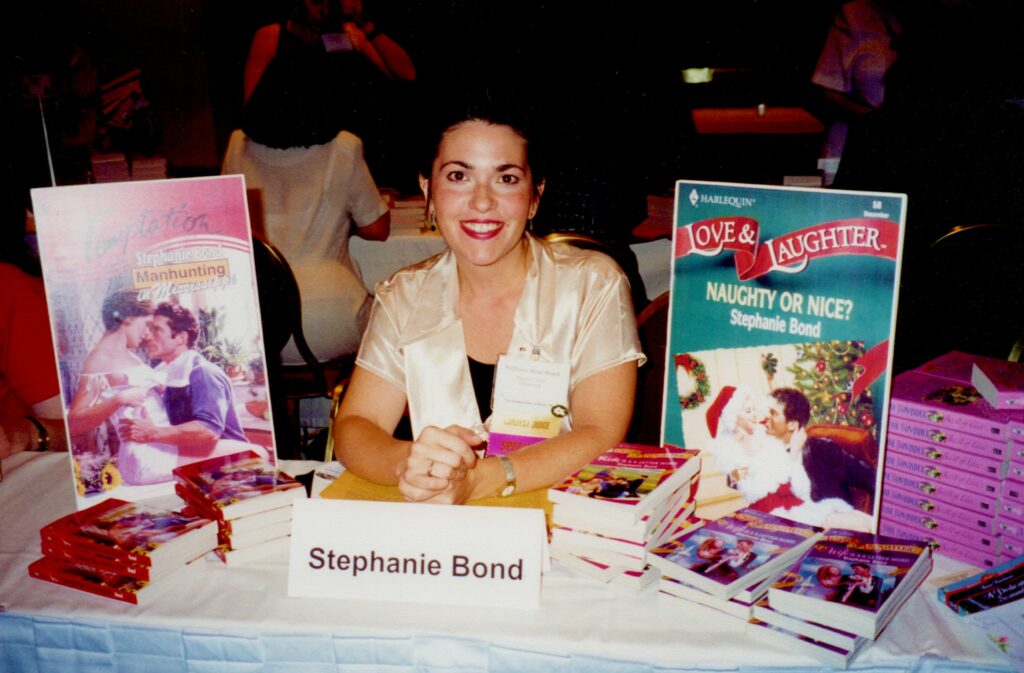
The BEST part of being a writer—meeting readers at booksignings!
In the following year, I would release another two books for Harlequin, but the void of writing for Bantam would send me searching for another second publisher and taking on the challenge of writing a "bigger" book—and (yikes!) wondering if I could pull it off. ~
→Go to Chapter 9: Steamier Romances… and a New Challenge
←Return to Chapter 6: Keeping My Head Above Water
(A reminder that I've included links to people, places, and things you might find interesting.)
Back in the late 1990s, I stunned a lot of friends and coworkers when I left my corporate job to write fiction full-time. Even though I transitioned from one career to the other by dropping back to part-time contractor on my programming job for a year and writing several manuscripts at the same time, many people commented when it came down to it, they didn't think I'd really leave. After all, it was a little crazy to think I could make a living writing romance novels, and it flew in the face of image people had of me. (Predictable, risk-averse, conservative, company girl.) And did I mention I left the company my father retired from? And what about that degree in computer science I was walking away from? And an MBA? Hadn't I wasted all that time? Because you don't need a degree to become a novelist. If I'd been on the outside looking in, I probably would've looked askance at me, too.
At the same time, I was bombarded by other people with requests to "pick my brain" over how they could leave their jobs to follow a more creative path. And if I had a dollar for every time I've been asked that question over the past three decades, I wouldn't need a job at all. 😊 Those requests accelerated during the 2020 pandemic when many people decided working from home was preferable to commuting, and the movement that become known as "The Great Resignation" ensued, with people giving up their corporate jobs in herds to pursue their passion.
So what would I tell someone who aspires to give up their day job to become a full-time writer, painter, crafter, musician, actor, singer, or other creative pursuit?
I'd try to talk them out of it.
Bear with me here. If someone has the impulse to pursue a vocation (here's the important part) in which other people will work for free, it's going to be an uphill climb. Specifically:
It's hard to make a living as a writer when lots of people are happy to pay someone to publish their work and then give away their book just to see their name on the cover.
Likewise, it's hard to make a living as a painter when lots of people will create paintings and give them away. It's hard to make a living creating handcrafts when lots of people do it as a hobby and give away their creations or are happy to break even on their investment. It's hard to make a living as a musician, actor, or singer when so many talented people are willing to take the gig for free just to get the exposure.
So if I can dissuade someone from following their "dream" in one conversation, they don't have what it takes to make it IF their goal is to make a living from their passion.
In other words, it's simple economics of supply and demand. If you want to do what a lot of other people want to do, and you expect to make money doing it, you should be prepared to work your tuckus off to get great at that thing because the competition is keen.
So for someone seeking my advice my initial questions would be:
How long have you wanted to do this?
What is your goal?
What have you done so far toward this goal?
What kinds of things do you plan to do in the future to move you toward your goal?
What kind of timeline are you on?
What would success look like to you?
What would make you quit?
The point is, if the person I'm talking to has a head full of dreamy notions about being a creative and they're on the verge of quitting their job to do it, I want them to stop and consider the realities. Because if the person quits their job to throw themselves into something unprepared, chances are they're going to fall short, and now they're in financial straits. Then they throw up their hands and retreat and feel like a big failure.
And I don't want you to feel like a big failure. I want you to follow your creative pursuits in a way that will enrich your life. Creative pursuits are supposed to be fun and something you look forward to, rather than mired in expectations and the stress of producing a revenue stream.
There are some caveats, of course, that will increase the likelihood of success. If you have connections inside whatever industry you're trying to crack, that will absolutely give you a leg up. If, for example:
—you want to be a writer and you're a descendant of Ernest Hemingway
—you want to be a painter and your aunt owns an art gallery
—you want to be an artisan and you learn an obscure craft from a known expert
—you want to be a musician and you have a buddy who's a successful studio sound engineer
—you want to be an actor and your college roommate works in Central Casting in Hollywood
—you want to be a singer and you live next door to Kelly Clarkson's mother
Then you might be able to milk that connection to get you closer to the front of the line. But again, you have to be ready to take advantage of that break when it happens by wowing the decision-makers with your talent.
I'd like to debunk one myth that seems common among people who want to jump to a creative career: that if you quit your job, you'll have more time to do your creative work. That's not necessarily true. I wrote just as much (and maybe more) when I was working full-time and part-time on my corporate job. When you have a certain amount of time to do your creative work, you have to do it; when you have all day to do that same amount of work, you might get to it… but more likely, you'll while away the day doing other things and then tell yourself you'll get a fresh start the next day. And then one lost day bleeds into the next, and the next. I speak from experience! The first few days after I left my corporate job felt a little "floaty." I suddenly had more time to write than ever before, and suddenly, the urgency to get to my wordcount was a little less. And frankly, after basically working two full-time jobs for years, I felt as if I deserved a little break.
But it totally messed with my momentum. Thankfully, my delivery deadlines helped me to get back on track. If you quit your job without having paying customers and delivery deadlines for your creative pursuit, you'll have to summon a herculean amount of discipline to stay productive. With all these things in mind, I counseled friends and relatives to be conservative when making their own transition to a creative career. And for my effort, I was often met with the response that I was a "killjoy" and/or that I "had my thing but didn't want anyone else to have their thing."
As if I wanted to keep this creative career space all to myself!
So despite my advice, several friends and people close to me left their corporate jobs abruptly only to realize several months down the line that they had unrealistic expectations about 1) their skill level as compared to the competition, 2) the demand for their product or service, or 3) the financial truths of running a creative business. Things did not end well for these people—their reactions ranged from disappointment to downright bitterness as they were forced to rejoin the corporate work force. (Especially painful for the ones who quit their original job in a performative blaze of glory.) I observed all of this with a sick feeling in my stomach because I saw them eventually turn away from their creative pursuit, probably for good.
One friend quit his lucrative project management job to flip houses… turns out he was watching way too much HGTV. He nearly bankrupted his family.
Another acquaintance left his corporate job to pursue a new painting hobby as a career and spent the next couple of years learning the harsh realities of the highly competitive field of art before calling it quits.
Another friend with no experience running a business quit her job to buy a struggling coffee shop, with the idea of turning it into a bookstore. One year later she sold the shop at a loss and returned to her previous field, now under a mountain of debt she'd acquired.
The better approach? Baby steps. If you're feeling stifled in your day job, consider looking for ways to expand or change your job description to include more creativity, or look for a new position within your current company. If that isn't possible, use time outside of your day job to deepen your knowledge or skill set in your creative field—take night or evening classes or find ways to volunteer your services. Get an internship or part-time job to "shadow" people who are already doing what you're doing to see what it's like. Use this time to practice getting great at your creative calling before you're under pressure to make money doing it. At the end of these exercises if you still aspire to make your passion your career, your chances of success will be exponential what they would've been.
A good resource for those who are feeling called to follow their passion is So Good They Can't Ignore You by Cal Newport. The author proposes that enthusiasm alone isn't enough to achieve success in a chosen field. You have to develop enough skill to carry you through, and in acquiring the skill, you will learn so much about yourself and your capacity for risk and hard work. You might decide you'd rather turn your creative calling into a beloved hobby versus a vocation... or you might decide to double-down and become even more committed to making the jump to a creative career. Regardless, if you've been considering a career change to follow your passion, I hope this helps you decide your next step.
Okay, back to my passion of writing fiction!
I'd learned a lot from writing KIDS is a 4-Letter Word—I was starting to get the hang of what was being asked of me by my Harlequin editor for the Love & Laughter line I was writing for. While writing KIDS, my critique partner Rita Herron made the comment that she thought the secondary character Pamela Kaminski, deserved her own story. I loved the idea of a linked book, so I talked to my editor, and she agreed. Because Pam had declared she never intended to get married, I titled the follow up book WIFE is a 4-Letter Word:
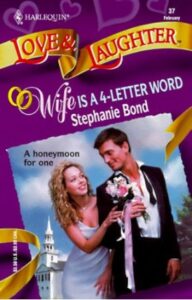
Original cover of WIFE is a 4-Letter Word000000000000000000000 released February 1998. Note that the hero in this book is blond and bespectacled, but the thinking at the time was that blond men were difficult to depict on covers and were less attractive to readers, so my fair-haired hero was given dark hair (and no glasses).
Also, by this time my first book Irresistible? had been out for a while--and to my delight and surprise, had been judged a finalist in the Romance Writers of America RITA Award of Excellence in the Best First Book category. Also, Harlequin had received letters from readers about how much they liked the best friend character of Manny in that book, so my editor asked if I could find a way to include him in WIFE. I did, and that exercise helped me to realize how fun it could be to revisit characters in subsequent books, which I would come to do again and again!
In WIFE is a 4-Letter Word, the jilted groom Alan asks the maid of honor Pam to go with him on his honeymoon—strictly as friends, of course because the strait-laced man and the bohemian woman could never be attracted to each other… or could they?
A couple of years ago Harlequin reverted the rights of WIFE back to me, giving me the chance to update it for re-release. When it comes to writing romantic comedy, there is nothing more delightful than writing about two opposite personalities who are so attracted to each other, they can't keep their hands off each other… and that physical attraction leads to deeper feelings. If you missed WIFE is a 4-Letter Word, it's available in ebook on all the online bookstores:
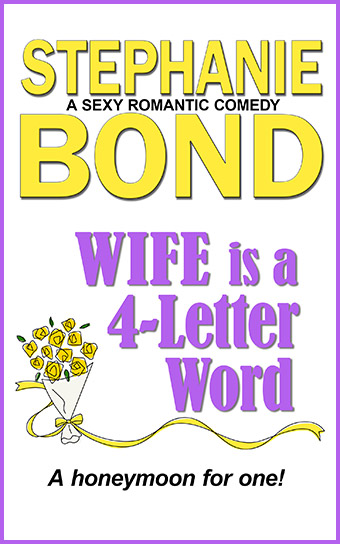
The cover for the updated version of WIFE is a 4-Letter Word
Back in 1998 at the same time WIFE is a 4-Letter Word was released, Bantam released what would be my third and last book for the Loveswept line, Your Wish is My Command. For that book, my editor asked me to retell a fairy tale.

Original cover of Your Wish is My Command, written under my pen name Stephanie Bancroft
I chose the folktale Alladin and His Wonder Lamp, and plotted a modern story around an antiques dealer in Sacramento, California, who's in love with the governor's girlfriend, and who unwittingly releases a genie from a lamp and wishes himself into a hole the size of the Grand Canyon! I really, really love this story and the opportunity to include the hero's family as instigators of the romantic setup. This story reminds me of the old-school romantic comedy movies of the 1980s with a lively cast of characters and a hero and heroine you just want to end up together. I hope you agree! Bantam reverted the rights to me years later and I updated the story, plus changed the title to the more modern-sounding Three Wishes. If you missed Three Wishes, it's available in ebook, print and audio!
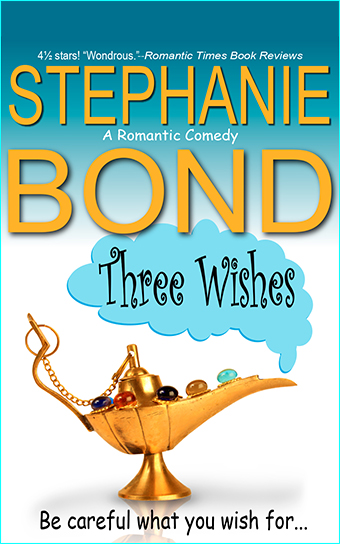
New cover and title for the updated version!
Throughout 1998 I was doing booksignings when I could to promote everything.
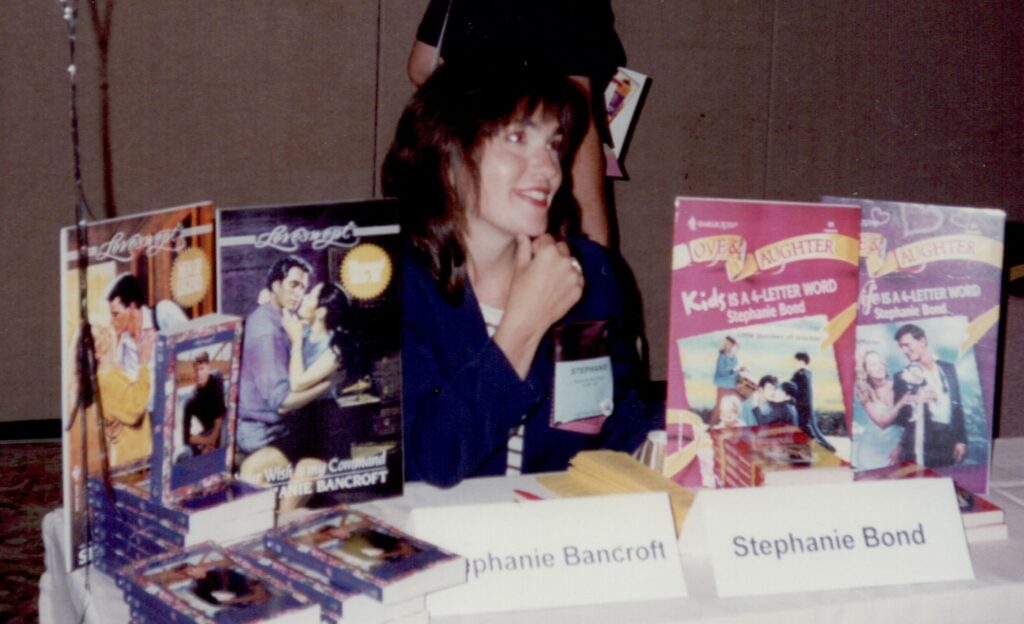
Me at a booksigning for four of my early titles, 1998.
And I LOVE the following photo! The sweet Patty Greenhill who ran the deli at the former Stamper Bros supermarket in Olive Hill was a big fan of my books so she arranged for my books to be sold right there at the meat counter! (The pun wasn't lost on me.) Note the pans of meat in the case below my books. 😊
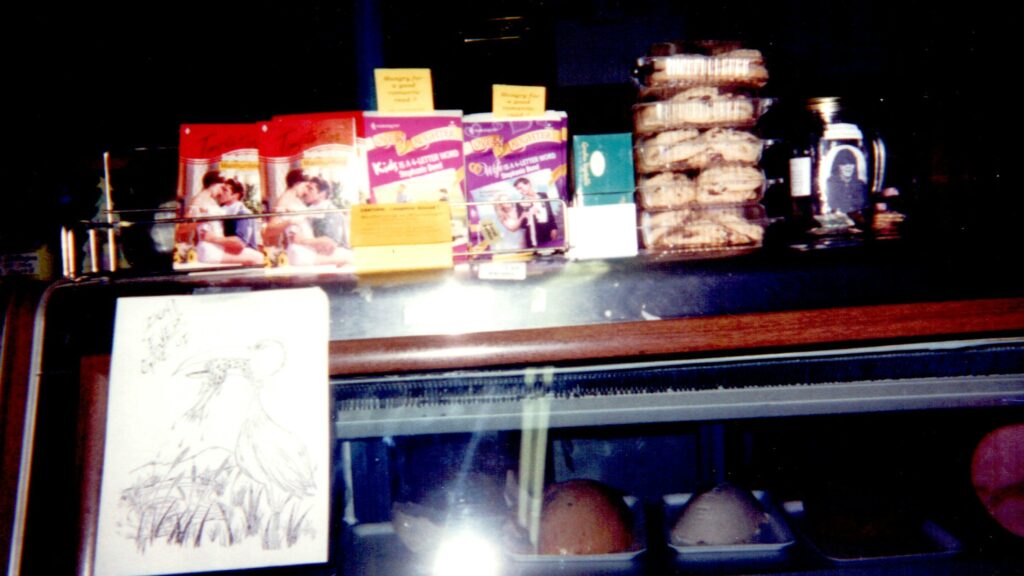
Featured "meat" of the week at the former Stamper Bros Supermarket in Olive Hill, Kentucky!
My career was really heating up and I was writing all day and most nights and weekends to meet my deadlines. I was working on several projects at once—pitching new ideas, writing a current book, doing line edits on a previous book, and proofing galleys on a book about to go into production. It was crazy-making, but so exciting! Things were about to change, however, as I would learn first-hand that publishing lines can sometimes end abruptly, and I would have to pivot. ~
←Return to Chapter 5: Writing Full-Time, Sink or Swim
It was fall 1997, and I was still settling into a schedule of writing full-time. It was an awkward transition, going from a life where every single weekday I was on someone else's schedule, to suddenly being in charge of structuring my own workday.
For those of you too young to remember, not very many people were working from home in that era; I can only think of a few at-home vocations: sales reps, real estate agents, and freelancers. And most full-time writers are freelancers. We basically get paid by the job and are constantly working to set up our next gig. But at the time, writing romance novels for traditional publishers was one of the most consistent writing jobs available.
Romance novels were and still are phenomenally popular—they represent about half of all the fiction sold in the United States. The other half is made of every other genre (mystery, thrillers, science fiction, horror, etc.) combined. To supply that demand, traditional publishers were releasing hundreds of romance novels every month that were distributed through bookstores, discount stores, groceries, pharmacies, etc., and direct-to-consumer subscriptions. Publishers like Harlequin, Ballantyne, HarperCollins, St. Martin's Press, Kensington, Dorchester, BET, and Penguin/Random House were buying romance manuscripts. Walmart even got in on the action for a while with their own imprints that were carried exclusively in their stores. Selling a manuscript back then was far from easy, but there was a guaranteed market for writers who were willing to work hard, network, and hold out for their lucky break—because sometimes it did come down to luck, having the right story in the right place at the right time. Most of freelance work is that way—having what the buyer wants when the buyer wants it, and networking to meet those buyers.
I was one of the lucky ones—I was now in the system. I'd sold manuscripts to two publishers—Harlequin and Bantam—and I was working with two editors I liked and who seemed to like my writing.
My third romance novel to be released was License to Thrill for the Bantam Loveswept line in October of 1997, again under the pen name Stephanie Bancroft. My editor asked me to contribute a story to a mini-series called Men of Legend. I could base the hero in my story on any real or fictional hero, and I chose a British agent in the vein of a contemporary James Bond. In License to Thrill, a former agent is tasked with the somewhat superfluous task (in his opinion) of accompanying a priceless historical love letter to America for an exhibit. When the letter is stolen and the curator of the exhibit, a curvy American spitfire, is accused of the theft, the agent has to figure out if she's guilty, and keep her from stealing his heart in the process!
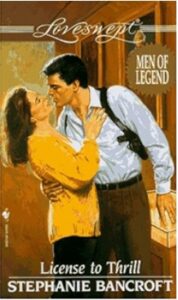
Original cover of LICENSE TO THRILL. By this time, Loveswept had abandoned the short-lived "hero covers" and returned to paintings/illustrations of couples in a "clench" pose.
I had a lot of fun writing License to Thrill. Bantam Loveswept prided itself on offering readers short, contemporary romance stories that didn't fit into a box (a swipe at Harlequin's category romance lines). Indeed, I saw it as a chance to write stories and characters that fell outside the Harlequin guidelines. I made my heroine, Kat McKray, a plus-sized heroine back when body-positivity wasn't a thing! (In my story there's a mention of The Cabbage Soup Diet that was popular in the mid 1990s. Here's a link to a copy of the soup recipe on Food.com.) I leaned on my British literary agent for details on mannerisms and dialogue to portray my hero, James Donovan, as accurately as possible. And License to Thrill was the first mystery I tackled, which would set the tone for future mystery series I would write further into my career. A few years after it was published, I got the rights back to License to Thrill and in 2011, I updated the story and republished it with a new cover:
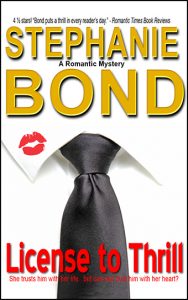
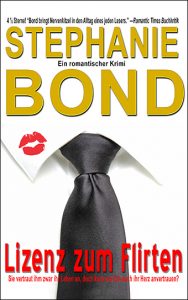
If you missed License to Thrill, it's available everywhere in ebook, print, and audio, and in German!
Back to being a full-time writer… you might be wondering, what WAS I doing all day?
Before an author is published, "the work" is basically a combination of writing and networking to try to sell the writing to a publisher. But once a book is released, "the work" is also promoting the books to booksellers, librarians, and readers. So I had to figure out how to split my workday into two main categories: the writing side of the business, and the business side of the business. My deadlines were my top priority, so I used a big wall calendar to keep track of when manuscripts were due, and production deadlines in between (when revisions and edits were due back, plus art fact sheets, etc.). When I was working on a manuscript, I would literally break down my production by how many words I needed to write every day in order to meet the deadline. Back then everything was handled through the mail, so I had to factor in delivery times.
Logistically, I had a "laptop" that was a refurbished Dell and weighed a ton—like twenty pounds or something, and it was about six inches thick. And it was breathtakingly expensive—around $3500. Plus personal computers back then were pretty glitchy and slow; every work session felt a little precarious. Email wasn't yet common—I had an email address and so did my editors, but when I sent them email, I usually had to call them to tell them to read it! (Are you laughing?) And I went through reams of paper. I bought printer paper like a small business.
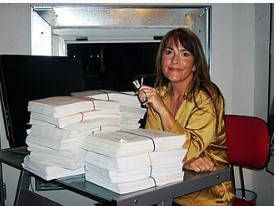
Me at my desk farther into my career with stacks of manuscripts—ugh, look at all that paper!
Any extra time in the day or week I spent on various promotional activities—setting up booksignings and talks, writing articles for exposure, and printing bookmarks and other giveaways for conferences and reader events.
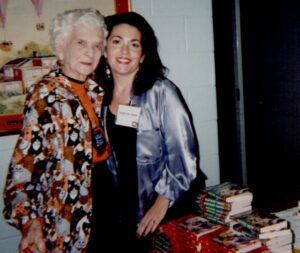
Miss June Ross, who taught me third and fourth grade and whose story would later inspire one of my most popular novels (COMA GIRL), and me, at a booksigning in my hometown of Olive Hill, Kentucky, circa 1998.
I still attended monthly meetings of Georgia Romance Writers (GRW), and the annual Romance Writers of America conference, plus other RWA-affiliated conferences. Writing groups began to invite me to lead workshops and I really enjoyed sharing my newbie knowledge. I absolutely loved everything about the writing industry—I loved the people, I loved the product, and I loved the audience. I felt perfectly situated in my new career, and I was firing on all cylinders. I knew I was still a publishing novice, but I was soaking up all the knowledge I could. I was determined to make a go of being a full-time novelist!
My fourth romance novel was a romantic comedy titled KIDS is a 4-Letter Word published by Harlequin. I love this story! The heroine, Jo Montgomery, is an interior designer and hardcore career woman who doesn’t want kids. But when she finds herself in the middle of someone else's family crisis and a potential client mistakes her for a mommy, she goes along with it… and the lie balloons out of control!
This story was originally released in January 1998 with the following cover, which I really liked:
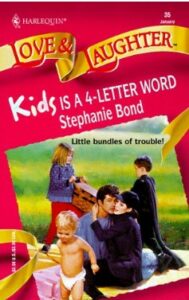
Original cover of KIDS IS A 4-LETTER WORD
Reviews were great, but sales were a little disappointing. My editor later told me booksellers and readers were confused by the title font on the cover—apparently, some thought it was a children's book! It just goes to show how everyone involved in the making of a book cover (including the author!) can get it wrong, ack. The book would go on, though, to be re-released many times (with different covers). The publisher recently reverted the rights and I revamped the manuscript for re-release. And guess what? I still love this story! I had forgotten how positively yummy the hero is. I had to update cultural and technological references, plus I tweaked the writing quite a bit to tighten things up, but I think the story held up pretty well. I put a new cover on it for re-release:
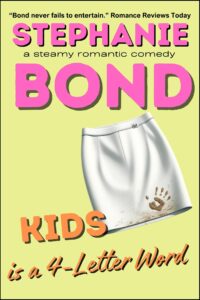
Kids is a 4-Letter Word, newly updated for re-release in ebook and print!)
Reading back over Kids is a 4-Letter Word reminded me how much I love this job. But being a writer is an oddball career—only writers truly understand other writers. I mentioned previously that old friends and new acquaintances couldn't wrap their head around the fact that I was actually working when, in fact, most weeks I worked 60 hours or more. To others, it seemed as if I'd left my stodgy corporate job to do something "fun," so it couldn't be classified as "work." When I attended social get-togethers with non-writers, half the people I talked to were dismissive of my new career, and half the people pelted me with questions about how they, too, could make the leap from the corporate world into a creative job—a question that nearly thirty years later, continues to come up, maybe more now than ever. So in the next chapter, I'll share my advice to aspiring writers, artists, musicians, crafters, and other freelance entrepreneurs for making the leap into a creative career.
Oh, and I'll be sharing more about my books, too! I hope you'll come back! ~
←Return to Chapter 4: Becoming a Full-Time Writer
(A reminder that I’ve sprinkled links throughout the text for more information on people, places, and things mentioned in case something piques your interest.)
It was July of 1997, and I'd just taken a leap of faith and left my stable corporate job as a systems engineer to write fiction full-time. I was nervous… but so excited!
By this time my first few romance titles had been released: Irresistible? was a romantic comedy for Harlequin about a woman who signs up for a clinical study on pheromones. Almost a Family was a family drama for the Bantam Loveswept line about a young married couple whose infant is kidnapped from a grocery store and returned to them 10 years later after they've divorced. A reminder that both books have been updated and are now available if you missed them.
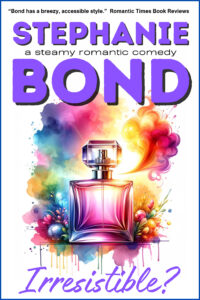
Irresistible? available in ebook and in print).

An early reference to Irresistible? in a column called On-Line Romance (the Internet was still new) in Romantic Times magazine written by the wonderful librarian/author Cathie Linz. It was the first I knew about the "buzz" the book was receiving!
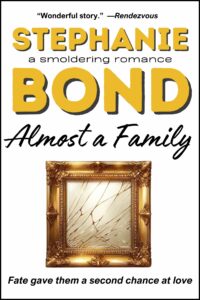
Almost a Family is available everywhere in ebook, print, and audio. This story is the only romance I've written that isn't a comedy.
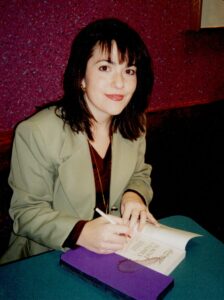
Me signing Almost a Family at a booksigning in 1997.
Also, my Harlequin editor had purchased other book ideas from me. I'd pitched a story about an interior designer who needs to land an account in order to purchase a piece of software that's crucial to her business. But first she visits the home of a client to find his nanny under siege. When the nanny flees, the woman has no choice but to take the kids with her to pitch the owners of the childcare centers. She gets the business because they think she's a mother, and she has to keep the lie going and keep it from their handsome widower dad!
I originally titled the story Mommy-itis, and while the title sounds cute, we realized the word looks confusing when written, so we settled on the title KIDS is a 4-Letter Word.
The rights to KIDS is a 4-Letter Word were recently reverted to me, so I recently revamped it to re-release. (And yes, it needed a lot of work, especially where technological references are concerned!) If you missed KIDS is a 4-Letter Word the first time around or would like to read the updated version, click here to order the ebook or print version.

Kids is a 4-Letter Word, newly updated for re-release!
A reader posted a question about how rights to books are reverted, so I'll do my best to explain the process, which varies from publisher to publisher, and can vary from contract to contract. Also, know that contract terms reflect the current state of the industry, so contracts I signed in the mid 1990s differ from contracts offered in subsequent decades. But in general, here's how it works:
When an author finishes writing a book, boom! they have an instant copyright to the material. Legally, the author doesn't have to file/pay to register the copyright with the U.S. Copyright Office, although it's extra protection if the author takes that additional step. Regardless, the copyright is good for the lifetime of the author, plus 70 years. Yes, that's a long, long time and personally, I don't believe most writers realize the ramifications of having an asset that goes on after they pass away.
When an author sells a book to a publisher, we're selling the license to our copyright, for a maximum of 35 years. (The 35-year limit is for books written after 1978; authors have Harper Lee to thank in part for that limitation because To Kill a Mockingbird was bought for $1,000 and would go on to be one of the most successful books ever written, with Lee receiving very little of the overall proceeds. The 35-year limit allows the author to get their rights back and renegotiate its value in the event it's a monster hit and the original contract is no longer fair.) Note also that copyright law differs from country to country. Click here for a link to Wikipedia's writeup concerning Copyright Law in the U.S.
Okay, bear with me—this is a little boring, but it's important for writers and writers' family members to know some basics about rights licensing and rights reversion. And this might help readers understand how different versions of a book can exist over its lifetime.
The contract an author signs typically doesn't spell out the term of the rights license in years. Although Stephen King famously has done this from the beginning of his career and some big-name authors can limit their rights license (for example, to 10 years), the rest of us mere mortal authors agree to an open-end license (up to 35 years as described in the previous paragraph) and rights reversion terms that are set by the publisher. In my early contracts, rights were eligible for reversion when the book went "out of print" or when sales dropped below a certain threshold and a certain amount of time had passed since its release. The evolution of ebooks means a book can no longer logistically be "out of print," but the other terms still apply.
It's up to the author to examine their royalty statements to see when and if a book is eligible for rights reversion. If it is, the author (or the author's agent) sends a letter or email to the publisher's legal department requesting reversion. The request is reviewed and the publisher can either grant the reversion request or repackage and re-release the book within a certain amount of time. Note that if the publisher elects to re-release the book, the terms of reversion are reset. And that process can continue until the 35-year legal limitation is met. But unless a book is a mega bestseller, most publishers recognize that commercial books become dated and un-sellable after a couple of decades, and usually sooner. Note that publishers don't have the right to update books on their own—only the owner of the copyright can meaningfully alter the material. And remember, although the publisher has licensed the copyright, the author is still the owner of the copyright for their lifetime plus 70 years.
This copyright ownership/licensing process also applies to music, although it's more common for songwriters to sell their copyrights, sometimes at the beginning of their career when they have less leverage. When you hear that big name songwriters have sold their song catalog for enormous amounts (Bruce Springsteen, Sting, The Beatles), those deals are copyright buyouts.
So if you're reading this and you're an author who sold to a publisher in the past and you've lost track of your rights, I urge you to look into whether the rights are eligible for reversion. Ditto if you're reading this and you're the heir of an author who has passed. My mind is boggled when I think about the number of books whose rights are simply floating around out there, forgotten and abandoned because the heirs don't know what to do and publishers don't care because it's not their responsibility to keep track of book rights. If the book is still earning royalties, of course those are going to the author's estate, but if a book is so out of date or has been pulled from distribution and isn't earning royalties, it's just lying there, fallow, when it could be generating revenue and allowing the author's name to keep going.
Okay, off my soapbox! And back to transitioning to writing full-time.
I remember the day I woke up and for the first time in my adult life, didn't have to report to a job. It was surreal. I worked on my manuscripts and got my home office organized, but I confess it all felt rather dreamy and it took me a few days to establish a structured writing day.
And I learned rather quickly I had to protect my time! Friends who were still working 9 to 5 would call me when they wanted to kill time and ask how was it, breaking away from the corporate world? Other friends, relatives, and neighbors saw my new status as an opportunity to make me their personal assistant! I would get calls anytime someone needed a favor (because I wasn't really working) and people would drop by unannounced. People expected me to host social events and sign up for neighborhood activities. Also, another phenomenon occurred that people who work from home are acquainted with: suddenly every domestic chore and errand that was previously shared is theirs because they're not really working. And it's so much easier to run to the grocery/drycleaners/post office/tax office during the day than to wait until evening or weekends when it's more crowded. Or mow the lawn in the middle of the day Tuesday to spare the other person from having to do it when they get home. Ditto for cooking and cleaning.
Again, this is difficult to put into words, but it was as if people were trying to punish me for leaving my corporate job to do something creative. And I let people make me feel guilty because it felt so indulgent to me, too, even though I'd worked like mad to slowly transition into writing full-time. I pushed back, but not nearly enough. I was suddenly busier than I'd ever been, trying to write and keep everyone happy. I squeezed in as much writing time as I could during the day. I was still meeting with my critique group once a week, and attending all-day Georgia Romance Writers meetings every month, plus doing booksignings and interviews whenever I could to scare up exposure and publicity.
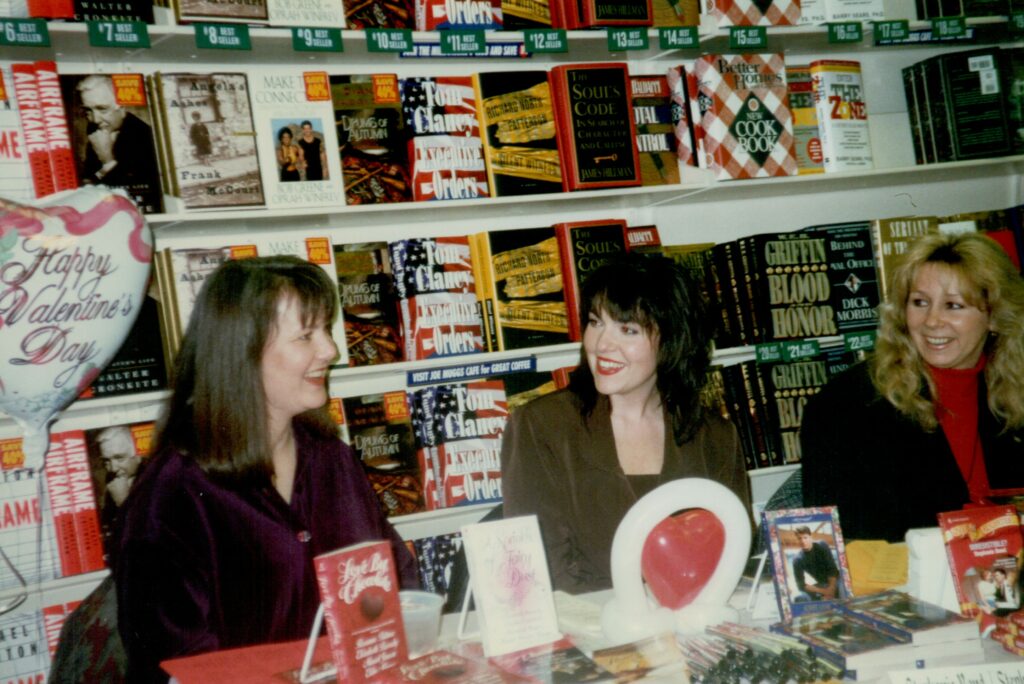
Elizabeth Bevarly, me, and Lori Foster at a Valentine's themed booksigning in Louisville, Kentucky 1997
Unfortunately, I unwittingly set a pace for myself and expectations from others that would eventually come to a head. More about that later. Mostly, though, I look back on those days fondly, when writing was still new and exciting, and I was still finding my way.
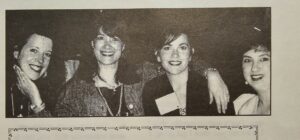
Lyn/Virginia Ellis, Cheryl Anne Porter, me, and Julie Leto at the Moonlight & Magnolias writing conference in Atlanta
A couple of weird things come to mind when I think back to the time after my first books were released. First, the number of sly remarks I received from people who seemed to think I was writing about my own personal experiences! While most authors do draw from things they know about—setting stories in places where they've lived or drawing on jobs they've held, most authors are flying on sheer imagination—that's kind of why we got into this business, because we have so many fictional characters and what-ifs flying through our brains.
Second… I'm trying to figure out the best way to say this… I was flabbergasted then and as my career progressed by the number of people who seemed angry about the fact that I was writing romance novels. I can't count the times someone seemed happy to find out I was a writer, then would ask what I write. When I told them romance novels, they would make a face or recoil—or both—and ask why? And when was I going to write (fill in the blank with a topic they wanted to read about)? (Because my career was all about them.) Those people didn't hide their feelings, but other people would be nicer, would comment had I ever thought about writing other types of books? I would just smile and say no, that I loved reading romance novels, and I loved writing them, too.
Funnily, some people would also go to extremes to point out perceived errors in my books. Don't get me wrong, I make mistakes all the time and I'm grateful when people let me know about story errors so I can correct them, if possible. But I remember one friend who was particularly incensed that I'd made the ginger cat in Irresistible? a female cat—she said that was impossible because all ginger cats were male. That's not true by the way, but I wasn't exactly a cat person back then and Googling wasn't yet a thing, so at the time I really couldn't argue with her. Besides, she was passionate to the point of gleeful about how utterly wrong I was about a detail in my novel, as if that somehow invalidated its publication altogether. Like I said—weird.
Also, some friends would introduce me to others as their author friend, and then whisper behind their hand that I wrote "erotic" novels or "those kinds of books" as a caveat. Someone who was once close to me who shall go unnamed said I wrote "dummy" books. A complete stranger on an airplane once struck up a conversation and then berated me for writing "trash." Honestly, I could go on and on… it was bizarre to me that people seemed to take ownership of my career and felt completely justified in telling me I should be writing something else. In time I would come to realize those people were projecting onto me their own dreams of being a writer that they didn't have the guts to pursue. Or they wanted me to write something more literary so they could show me off as their "lit-rary" friend.
But thankfully, for every turd out there who tried to make me feel less than, there were dozens (hundreds, thousands) of people who were thrilled to learn I wrote books that were for pure entertainment. I personally think we lose a lot of potential readers in high school World Literature class—so many people have an unpleasant relationship with fiction because they were forced to read things they didn't enjoy or relate to. In the U.S., we've created a nation of literate non-readers. When I meet someone who says they don't like to read, I know it's only because they haven't found a book that interests them.
All this to say writing happy books makes me happy and I hope they make my readers happy, too. Life is hard, and if one of my books can distract someone from their problems for a few hours, I'm so pleased. Not everyone can say that about their job. I'm a very fortunate person… and I'm glad that after I took the leap, I kept swimming!
That said, work and life would become much more challenging... ~
←Return to Chapter 3: Writing and Selling My First Book
(A reminder that I’ve included links throughout the text for more information on people, places, and things mentioned in case something piques your interest.)
When I left off I was riding high on the publication of my first book Irresistible? in February 1997. It's hard to believe that as of this writing, that was over 27 years ago.
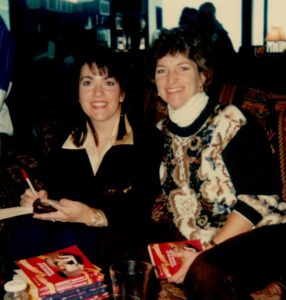
Me and friend Nancy McKenzie at a booksigning for my first book at Joseph-Beth Booksellers in Lexington, Kentucky
As I mentioned, my publisher recently reverted the rights to Irresistible?, which gave me the chance to update the story, both the writing and the cultural and technology references. Also, I decided to experiment with dropping small images into the text of story to enhance certain scenes. For example, here's a picture of the heroine's cat:
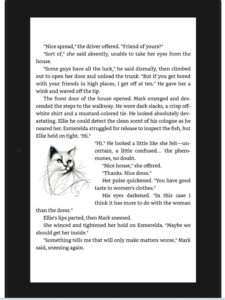
One of the images imbedded in the updated version of Irresistible?
If you read the updated version, please let me know what you think about having imbedded images… do you like them, or are they distracting? Your feedback will help me to decide whether to include imbedded images as I revamp more early titles.

Click here to buy or download a sample of Irresistible? Available in ebook and print!
But back to my story…
I mentioned in the previous chapter that while I was waiting for Irresistible? to be published, I sold a couple of other manuscripts. To recap, I sold Irresistible? to Harlequin Enterprises, which at that time, released most of their titles in lines known as category romances. Each book is released under the "brand" of a category, such as Harlequin Intrigue or, in the case of my first book, Love & Laughter.
The upside of selling to category romance lines is that the audience is already established—that's a huge leg up for a new author. The downside is the advances paid are on the small side, and when I first sold to Harlequin, authors didn't receive royalty payments until maybe a year after the book was published. Remember, I sold the book in December of 1995, but it wasn't published until February 1997. My goal was to be a full-time writer, but that meant replacing all or most of my income from my corporate job. In order to do that, I realized I was going to have to get several books in the publishing pipeline. But I was in a catch-22 position with Harlequin; a publisher is understandably reluctant to extend another contract to an author until they see how a first book performs, and the Love & Laughter line hadn't yet launched. My editor Brenda Chin seemed keen to buy another book from me, but her hands were tied.
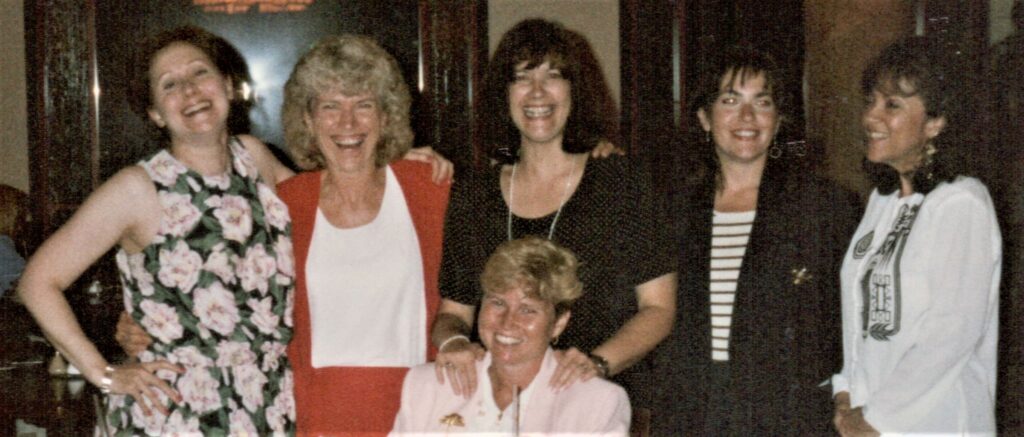
Some of the authors for the Harlequin Love & Laughter line:
L to R, standing: Bonnie Tucker, Vicki Lewis Thompson, Cheryl Anne Porter, me, Debbi Rawlins
Seated: Our editor Brenda Chin
So my agent suggested that we approach a rival publisher of category romances, Bantam Loveswept. When she contacted editor Shauna Summers at Loveswept, Shauna said my name rang a bell. It just so happened that she had a copy of a Georgia Romance Writers newsletter on her desk and had read a humorous "letter" I'd written to an anonymous editor about rejecting their rejection. It was a tongue-in-check response to every form rejection I and my writing friends had ever received. Shauna thought it was funny and mentioned she was attending a conference near Atlanta that I would also be attending. She arranged to meet me there.
In preparation for the meeting, I read as many Loveswepts as I could get my hands on to get an idea of the kind of story I should pitch. Loveswepts were short books like Harlequin's category romances (60,000 words, about 250 manuscript pages), but the books released each month ran the gamut from rom com to mystery to family drama.
At the conference, Shauna and I hit it off. She asked what I was writing for Harlequin and suggested that I submit something different for Loveswept. When I returned to Atlanta, I brainstormed a story about a couple who'd gotten married when they were young because of an unplanned pregnancy, then the infant had been kidnapped from a grocery store and their marriage hadn't survived the trauma. The story opened ten years later when their son is found—alive—and the couple has to reunite to co-parent. I submitted the proposal under the title Almost a Family, and Shauna bought it for the Loveswept line. I wrote the manuscript quickly and the book was given a publication date of March 1997, only one month after Irresistible?
At the time a clause in my Harlequin contract prevented me from writing for a competitor using the same name, so I had to choose a pen name for my Loveswept book. I stayed with Stephanie and for a surname I wanted to use something close to "Bond" so I chose "Bancroft."
Note: Harlequin's contract no longer requires an author to write under a different name for a competing publisher. If an author writes the same type of book for different publishers, the author will typically use the same name to create synergy. But there are business reasons for writing under different names:
At the time I sold my first book to Loveswept, Bantam had moved from illustrated "clench" covers that depicted a couple in an embrace to "hero covers" with the photograph of a man, a floral background and the title plus the author's name in a similar font. It was a move to set the books apart, and I was pleased to get a handsome man on my cover. (In hindsight, he resembles a young Al Gore!) But the hero covers were short-lived and later when I got the rights back, I chose a cover for the updated version of Almost a Family that reflected the storyline.
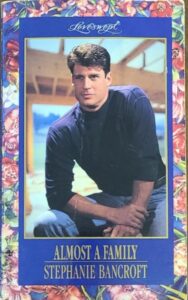
The original cover of ALMOST A FAMILY

The cover for the updated version of ALMOST A FAMILY
Almost a Family is perhaps the only book I've written that isn't a comedy, and I really love the characters. If you missed Almost a Family, it's available in ebook, print, and audio, plus in German! Click here for links to your favorite online bookstores.
On a personal note, I'd like to mention that I dedicated Almost a Family to my beloved Aunt Fonda who brought me bags of romance novels to read when I was young. Fonda knew I'd sold my first romance novels, but sadly, she passed away before my first books were published.
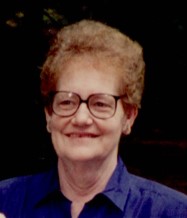
Fonda Sue Bond, who spread her love of reading to others, including me
After I sold the first couple of manuscripts, I arranged with my employer to go part-time as an independent contract programmer in order to have more time to write. After some experimentation with my schedule, I realized I was better off to sit-out the infamous Atlanta morning commute and work at home writing until noon, then drive to the office to work afternoons. For the next year, my workday was split evenly between writing and my corporate job, and I also spent many weekends writing.
When I sold the book to Bantam, my editor at Harlequin was given the greenlight to buy more books from me, and I sold more books to Bantam as well. Since I'd delivered complete manuscripts, now I was in a position to sell books on proposals and synopses.
Note: A synopsis is a 1-3 page description of a book, including information about the characters, the setup, how the story unfolds, and how it concludes. I'm always amused when aspiring writers tell me they can't write a story if they know how it ends. In order to sell a book to a traditional publisher, you have to prove you know how the story will end!
Now with ten sales under my belt to two publishers, I felt (somewhat) comfortable to give notice to my employer of my last day. I tied up loose ends to the projects I had underway and on July 11, 1997, said my goodbyes to coworkers. I'd spent ten years with the same company, and was now taking the big, huge, giant, colossal leap from being a corporate employee with a secure income and benefits to being a full-time novelist with no security and no benefits.
I hoped it would work out… but I truly didn't know. ~
→Go to Chapter 5: Writing Full Time, Sink or Swim
←Return to Chapter 2: My Writing Journal Begins
(A reminder that I’ve included links throughout the text for more information on people, places, and things mentioned in case something piques your interest.)
Oof. It was summer of 1995, I was living in the suburbs of Atlanta, Georgia, still working full-time as a systems engineer and writing romantic fiction in my spare time. And not only had I just promised Harlequin editor Brenda Chin I would send three chapters and a synopsis for a book I hadn’t even started, but I’d promised her it would be funny!
In the future I would come to realize I produce my best work under pressure, but at that moment, I had no confidence or proof that I could do anything of the sort. In hindsight, though, I did have a few things going for me.
I’d been reading romance novels for years and unwittingly soaking up the rhythm of storytelling and the “tropes” of the genre. A trope is an element that defines a certain type of story. For example, one romance trope is a happy ending, which is generally considered a requirement. Other popular tropes are love triangle, forced proximity, enemies to lovers, friends to lovers, reunion stories, opposites attract, etc. I inherently knew the tropes even though I hadn’t yet experimented with writing all of them, which is why I was able to pitch a humorous premise on the spot of a woman who enrolls in a clinical study on pheromones and suddenly becomes irresistible to every man she meets.
Also, I was a huge fan of romantic comedy movies of the time like When Harry Met Sally, Doc Hollywood, Pretty Woman, Sleepless in Seattle, and The Bodyguard, so I had a sense for what I liked about them. (People sometimes ask me if I patterned my first book after the rom com Love Potion No. 9, but as of this writing, strangely enough, I’ve never seen that movie, although I just added it to my watch list because I think I probably should see it.)
Also, since the romantic comedy line the editor was acquiring for hadn’t yet been launched, there were no guidelines except for wordcount, which was approximately 60,000 words. (As a reference, that’s about 250 double-spaced manuscript pages.) The fact that I didn’t have a lot of constraints and no books to read and learn from meant the possibilities were wide open.
And the final ace up my sleeve was my critique group. While Rita Herron has been my mainstay critique partner over the years, other members (Mary, Hilary, Pam, Carmen) came and went from our group that met weekly and all were very helpful in reading my pages and offering up feedback.
With those advantages and a cheering section, I set to work outlining a book with the premise I’d tossed out so casually.
Here is where I should back up a little and address comments I received at the time and still hear when people learn my first career was computer programming (now referred to using the much cooler phrase “coding”). The common observation is that writing fiction seems to be at the opposite end of the spectrum from programming computers—one seems wildly creative, and the other, notsomuch. But in truth, there’s a lot of creativity in coding because the goal is to write a program to solve a problem, and every programmer will do it differently. Also, coders are excellent typists! (Okay, keyboarders.) I’d be remiss if I didn’t acknowledge the fact that learning to touch-type in high school on an IBM Selectric Typewriter and keyboarding daily in college and in my job was a huge boon when it came to writing fiction in terms of sheer speed and accuracy.
Another skill I acquired in programming was outlining. When I first learned to program, processing speed was slow and storage space was limited, so it was critical to write an efficient program that was successful on the first or second pass. To that end, I learned to “flowchart” my programs—mapping out the process using certain shapes for certain functions. For example, a diamond shaped box indicated a decision that had to be made, with arrows pointing in different directions depending on results of the decision. I literally used a plastic template guide to draw the steps of my process and in many cases, the flowchart had to be attached to the actual program that was printed on green and white continuous paper as proof of working through a problem before attempting to write the program.
So when compared side by side, writing a computer program and writing a book aren’t so different in terms of process, and there are lots of transferrable skills.
When I sat down to think about the story I had to write, I started by figuring out what trope would work best with the logline I’d pitched. If my heroine would become irresistible to every man she met, the most humorous setup would be for the hero to be the kind of man who wouldn’t normally be attracted to her—namely, someone opposite. So my trope would be “opposites attract.”
Further, I reasoned if the heroine was the type of person who would sign up for a clinical study, she would be impulsive and adventurous, and since the primary reason to sign up to be a lab rat is compensation, she would have an unpredictable vocation. I dabbled in art most of my life as a hobby and enjoyed doing figure drawing. So to fall back on something I had some insight into, I made the heroine an artist struggling to make a name for herself. I gave her the "soft" name of Ellie (begins and ends with a vowel). For the hero to be opposite, I made him a corporate lawyer with the “hard” name of Mark (begins and ends with a consonant). Then I devised a way for them to have to work together (forced proximity): she would be commissioned to paint his corporate portrait since he’d just been named partner in his firm. That felt like a good setup because the hero would be at an inflection point in his career and life.
Okay, I had the plot of my story, but I still needed the setup and the “meet cute.” For the heroine to be forced to sign up for a study on pheromones, I opened with her being let go from her “day” job of working for a city art council. BUT for the “promise of the premise” to work (i.e., the heroine becomes irresistible), I also needed for her and the hero to meet before she enrolled in the study so we could see that he’s not bowled over by her (nor she by him) when they first cross paths. To show that, I decided to let her be sitting in a café going over job listings, and the distracted workaholic hero accidentally spills something on her while he’s on his phone. As strangers, they clash. Then the heroine signs up for the pheromone study and begins to take the pills. Then the heroine’s former boss, who feels terrible about having to let her go, passes her a commission from a local law firm to paint a corporate portrait. When the heroine shows up at the law firm, the hero and heroine realize they have to work together… and are attracted to each other. But is the hero interested only because of the pheromones? All of these elements I “flowcharted” in a word processing document and moved things around until the sequence made sense.
Sidebar: Can you see the black moment looming out there? She falls in love with him, but what happens when the clinical study is over and the pheromones vanish? For those of you interested in writing, it’s helpful if when you pitch the logline for your story, the black moment is obvious.
Okay, so I had my basic plot and my setup… now I just needed to write it! Easier said than done. Remember, I’d never written anything funny and didn’t know if I could. So I decided to borrow elements from those romantic comedy movies I loved. One of the tropes of rom coms of that era and a source of much of the humor was the gay best friend. I brought that trope into my story with the introduction of a character named Manny who would be my heroine’s roommate and confidante. Then I added more characters who would highlight the fact that the hero and heroine were opposites: the hero’s mother and family who have a certain type of woman in mind for the hero. I also gave the heroine a cat that the hero, who isn’t a pet person, would have to deal with.
And I layered in other details to prop up the general plotline in terms of scents and pheromones—I gave the heroine an interest in making her own perfume (which is why she’s attracted to the study in the first place). Gender mix-ups were all the rage in TV and movies at the time, so it gave me the idea to include a mix up regarding Ellie’s gay roommate. And lots of innuendo and double entendres.
I admit it—I put in everything I could think of that would make the story over the top because I was terrified the story wouldn’t be funny and I’d blow my chance to sell a book to the editor.
But I was also coming around to the idea that I enjoyed writing romantic comedy. I suppose what I didn't project in real life was something that came out naturally when I wrote, which is what the editor had recognized when she read my query letter in the workshop.
Writing every spare minute between my full-time job, I banged out a proposal (three chapters and a synopsis) in record time. I’d titled my story Irresistible, which seemed appropriate. My critique partners were kind enough to read my pages quickly and turn them around with comments. I printed the proposal and sent it off to editor Brenda Chin with a cover letter reminding her where we’d met and here’s the story she said she was interested in reading. And I waited to hear back.
And waited.
And waited.
Editors receive dozens of both requested and unsolicited manuscripts every day, which they have to read in addition to manuscripts they’ve already bought and are in different stages of the publishing process. So it’s not as if Brenda was sitting in her office waiting for my submission to arrive. I assumed she’d attended other writing events and had requested many manuscripts in the hopes some of them would fit the comedy line that was still being defined but now (I’d learned through a Romance Writers of America market update bulletin) was called Love & Laughter.
Meanwhile, since I had momentum, I decided to go ahead and finish writing the first draft of Irresistible, which I did over several weeks, workshopping it in my weekly critique group meetings.
A few months later, I attended the Moonlight & Magnolias writing conference in Atlanta sponsored by the Georgia Romance Writers. I hadn’t yet heard back from my submission, but I was still hopeful. At the conference I showed up for a workshop early and another woman was also early. We chatted and she introduced herself as an agent whose name I recognized. She asked what I wrote and I told her romantic comedy, as if I’d been doing it for years. She invited me to submit something to her and gave me her card. I was excited, but I managed to keep my cool (I think).
After the conference I submitted to her the finished manuscript of Irresistible and explained the proposal was with Brenda Chin who had requested it. At this point I was calling my home landline phone message machine to check for messages a couple of times a day, hoping for “good” news, and opening the mailbox when I got home, hoping not to see a returned envelope with “bad” news. One day I had a voice message from a woman with a British accent who introduced herself as Ruth Kagle, a colleague of the agent I’d spoken with at the conference. She said the original agent had decided my manuscript wasn’t for her but had passed it to Ruth who “quite liked it” and wanted to talk to me about representation. I was ecstatic! I returned Ruth’s call the following day and explained I hadn’t heard back from Brenda Chin as to whether she liked the proposal. Ruth said she’d call Brenda and let her know the manuscript was finished and if she wanted to read it, Ruth would send it to her before submitting it to other publishers.
Brenda did want to read the full manuscript, and meanwhile, I signed a representation agreement with Ruth’s agency. I was walking on air—a sale seemed to be within reach!
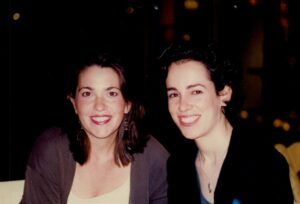
Me and my first literary agent Ruth Kagle.
Sidebar: A literary agent earns a percentage of all proceeds of their clients. No sale, no commission. But the general idea is an agent is worth more than their commission in terms of having direct access to editors to get projects read more quickly, and to negotiate higher advances than an author might be able to negotiate on their own. Material submitted through an agent is considered by editors to be “vetted” and typically—although not always—is considered a higher quality submission. Also, if an author has an agent, the editor has extra assurance that someone else will ensure the author delivers a manuscript on time. And some editors prefer to deal with agents when it comes to negotiating terms of a contract versus dealing with an unrepresented author who likely has to be schooled in what terms and clauses mean.
By this time it’s November of 1995. My day job was keeping me too busy to dwell too much on what was happening with my manuscript. I traveled alone to Sarasota, Florida to visit the headquarters of a small business my company was acquiring to get a handle on integrating their paperwork and systems into ours. The people at the office were rightfully worried about their jobs, so it wasn’t a welcoming atmosphere, combined with the fact that the hotel accommodations left a lot to be desired. Picture a musty room in an old strip motel with mismatched fake wood furniture and a wild flowered bedspread that hid unknown stains. The days were long and stressful—I stayed after hours to work alone. One night I dragged myself back to the motel late at night, then remembered to call my home phone messages to see if there was any news from my agent. To my surprise, she’d left a message to let me know that Brenda had called to make an offer on Irresistible! I was overjoyed! But it was too late to call my critique partners or family members to share my good news. Of course I was wide awake and wanting to celebrate!
So I left my room and walked to the outdoor vending machine in front of the motel and bought a can of ginger ale. I cracked it open and had a private little toast to my first sale. I know it sounds pitiful, but I still remember that sweet, sweet moment!
The next few weeks were like a bootcamp introduction to the world of publishing. My new editor Brenda called me to discuss revisions to the manuscript to get it into the best possible shape. One of the issues she brought up surprised me—at that time Harlequin had never featured an outted gay character in one of their books. So to be able to include Manny as-is, the decision had to make its way up to the top of the editorial ranks. Let me be clear that the hesitation was in no way reflective of how my editor or any individual at Harlequin felt about it—the top editorial execs had to decide how the inclusion would be received by readers at that time. Remember that many readers subscribed to Harlequin books and received every book in a particular line every month—they couldn’t pick and choose titles ahead of time. So including a gay character in a book that could be sent to readers who might not want to read about a gay character had to be weighed as a business decision.
While this was going on, I tackled other revisions to shape up the story, shore up characterization and improve the pacing. Brenda liked my title of Irresistible, but suggested we add a question mark to the end to make it more quirky and interesting. And I received my first publishing contract!
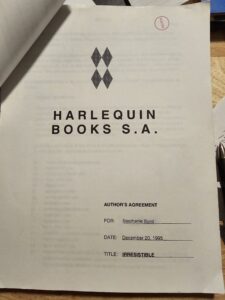
The title page of my first book contract.
Sidebar: It’s commonly believed that when an author signs a contract, they sell their copyright to the publisher, but that’s not the case unless the deal is specifically for and designated a “copyright buyout.” Generally, the author maintains ownership of their copyright and is simply licensing the use of the copyright to a publisher under terms spelled out in the contract in return for payment.
A book contract is a somewhat intimidating document about a half-inch thick that explains in detail what rights the publisher is licensing, and what rights are excluded and the author retains. For example, a publisher might purchase foreign language rights but exclude audiobook rights. The rights sold and retained are negotiated between the publisher and the author/the author’s agent. The contract also spells out payments to be made and at what times, royalty rates, sales bonuses, etc., plus the delivery date(s) and other actions the author agrees to, such as agreeing to promote a title when it’s released if the publisher sets up interviews, booksignings, etc. The contract also spells out the terms for which the licensing agreement can/will end and the rights will revert back to the author.
I went over the contract clause by clause with my agent until I understood what I was signing, then returned the contract. By the way, my first contract was for one book—that’s typical because it’s best for the publisher and the author to see if this arrangement is going to work out before committing to more than one project. But there’s usually a provision in the contract that the publisher gets first right of refusal on the author’s next project.
At the same time, I was going through two rounds of revisions with my editor. In those days, we were dealing with paper, so I would send the 250-page manuscript via Fedex to her in Toronto, she would write in the margins and attach sticky notes, then write a cover letter describing the revisions she was asking for and why, then send the flagged and marked-up manuscript back to me in Atlanta. By the way, I was given the go-ahead to leave the character of Manny in my manuscript as-is. 😊 Brenda and I talked on the phone when either of us had questions, and she informed me my release date had been scheduled for February 1997… more than a year away! But the Love & Laughter line (2 books per month) wasn’t even launching until summer of 1996. In terms of release dates, I was getting a plum month because February all media turns to highlighting romance, including romance novels.
I filled out a Cover Art Form with information about my story and the characters in preparation for a photo shoot of models that would then be turned into a painting for the cover. When the cycle of overall revisions was finally done, the manuscript was then line-edited, which is a pass for story clarity and continuity of time-line and other over-arching concepts, then again returned to me for corrections, which I made, then returned. Then the manuscript was copy-edited, which is a pass for correcting sentence structure, marking repetitive words, etc., and again returned to me for yet more corrections and to produce a clean paper copy. I went through reams of paper!
Finally, after nearly a year, Irresistible? was ready to go into production. A couple of months later I received the “galleys,” which was basically sheets of paper set up the way the book would look if it were open, two-pages up. I was given the chance to go through the galleys for final corrections before the book was printed. At this stage, only typos could be corrected. It was nerve-wracking, but it meant I was getting closer and closer to the publication date.
And meanwhile, I was writing and selling more books! I’ll wait until the next chapter to tell you more about those projects but suffice to say I quickly learned that to keep the momentum going, a writer had to get several books into the publishing pipeline to ensure a consistent release schedule. The good news is that once “the seal is broken” with an editor and a publishing house, it’s easier to sell subsequent books. At this point they’ve invested in you, so it’s in their best interests to keep you around long enough to make some money off you!
But also, I was holding my breath to see the cover for Irresistible? I remember the day I received the cover proof sheet in the mail—and I loved it!
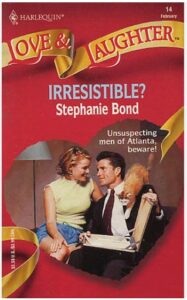
The original cover of my first book, Irresistible? published by Harlequin Enterprises February 1997.
Every author will tell you they feel like the book is real when two things happen—when you see the cover for the first time, and when you hold it in your hand. Speaking of which, in the contract the publisher specifies how many author copies will be provided. One day in January 1997, the doorbell rang, and I found a box from Harlequin on my doorstep… full of copies of my finished book! I was thrilled and couldn’t wait to send copies to my mom and take copies to members of my critique group. I set up a couple of local booksignings in Atlanta, and a dear cousin in my hometown of Olive Hill invited me to have a signing in his gift shop.
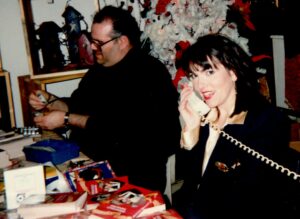
Me and my cousin Rick Stephens at his gift shop in Olive Hill, Kentucky where I had one of my first booksignings for my first book Irresistible? in February 1997. I’m not sure who I was talking to on the landline phone (remember cords, everyone?), but that was such a special day. The turnout of former classmates and teachers and customers of my store and family and friends was amazing!
Gosh, this has been such a wonderful trip down memory lane. Thank you for indulging me. I’m sure I don’t remember all the anxiety-producing moments of writing and revising that first book because I’m sure there were many! I do recall wondering if I could pull it off or if at some point, Brenda would decide she’d been had and cancel the contract. But as you can see, it all kind of worked out, and I was having the time of my life!
Now it’s (gulp!) 27 years later and coincidentally, Harlequin recently reverted the rights to my first book Irresistible? I’ve gone through it to update it and yikes, there was a lot to do.
First, technology has changed so much! And the pop culture references were so dated—I'll spare you and me the embarrassment of mentioning all of them, but here’s a short list of some of the many things I had to change. Do you remember when these things were normal?
And I know (hope) I’m a much better writer than I was when I first wrote Irresistible? I trimmed a lot, cut so many adverbs and over-writing, and generally smoothed out plot points so scenes blended more seamlessly. Ack, let me just say—I touched nearly every sentence in the book!
And while I was updating the story, I wanted to put a new cover on the book that’s more modern and more in line with my recent self-publishing branding in regard to where my name appears on the cover, etc. Because of my technical background, it probably won’t surprise you that I’m embracing Artificial Intelligence tools where they can make my life a little easier. So I asked text-to-image generator DALL-E to create a perfume bottle with bright colors and a watercolor background. It generated several images, but one in particular I really liked:
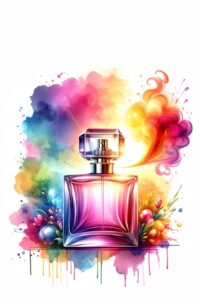
Image generated by text-to-image AI DALL-E in response to my prompt to create a perfume bottle with a colorful watercolor background.
So it’s the image I used to create a new cover for Irresistible? What do you think?

A new cover!
Plus I decided to experiment a little and I’m imbedding simple images into the text of the story to hopefully enhance the reading experience. (I’m counting on feedback from readers to let me know if you’d like to see more of that going forward as I continue to update early titles for re-release.)
And I’m happy to announce the newly updated version of Irresistible? is now available in ebook and print!
Pfew! Back to work for me. I hope you’re enjoying THE STORIES BEHIND THE STORIES. And thank you so much for your ongoing support! ~
→Go to Chapter 4: Becoming a Full-Time Writer
← Return to Chapter 1: Before the Writing Bug Bit Me
(A reminder that I’ve included links throughout the text for more information on people, places, and things mentioned in case something piques your interest.)
When I think back to the first time I booted up my desktop PC in 1994 to a blank screen of word processing software, I wonder why I wasn’t intimidated by the idea of writing a book. I think some of my false confidence came from the knowledge that no one else had to know and I was free to fail in secret. I don’t believe I mentioned it to anyone at the time. I had no grand aspirations of writing something to be published—I just remember thinking it would be a fun exercise.
You might be surprised by the first story I began to write—it was a historical romance set in Kentucky during the Civil War. Kentucky was splintered by the war, with split loyalties to the Northern and Southern causes, pitting brother against brother in some cases. Additionally, many interests in Kentucky were neutral, including the Shakers, a pacifist religious sect with a large presence in central Kentucky called Pleasant Hill. (The contained village of Pleasant Hill still operates as a preserved tourist and educational attraction of the simple, peaceful Shaker life. If you find yourself in or around central Kentucky, it is a lovely family experience set in a pastoral landscape.) During the war, Pleasant Hill was a sanctuary for starving and wounded soldiers from both sides, and I thought it would be an ideal setting for a story of romance and personal conflict on an epic scale. In hindsight, it was an ambitious undertaking for a first novel, but I didn’t know any better.
At the time, I gravitated to writing historical romance because it was what I most loved to read. Pretty quickly, however, I found myself bogged down in research—I could get lost for hours reading books about the Civil War era and the location of one of the bloodiest battles in nearby Perryville. Weeks later, I had pages of notes for my story, but I hadn’t made much progress in page count. So I made a decision that would set the course for my future writing career—I decided to switch to contemporary romance. That said, I still wasn’t getting very far on my own.
I subscribed to Writers Digest magazine and began to dabble in other types of writing—articles and short stories. I spent my Saturdays at the public library pouring over the voluminous copy of Writers Market, searching for the names of magazines accepting unsolicited ideas and written pieces. I’ve always been interested in fabric and clothing construction, so I submitted ideas to a sewing magazine and managed to sell a couple of articles. The checks were tiny, but they felt like a victory.
It was around this time that I began to share with family and friends that I was writing in my spare time. I signed up for a local fiction writing class, but ack, it wasn’t a great experience. The instructor, although well-intended, I’m sure, employed a woo-woo style and encouraged everyone to sit in a circle and read our work aloud in low lighting. (People who know me well are belly-laughing right now.) She wasn’t impressed with my stories about romance and intrigue that had a happy ending—she insisted that writing was about exploring philosophical ideals and delving into past trauma. It was my first revelation about the profound differences between literary and genre writing and helped me to realize I didn’t want to write certain types of stories. The class made me more committed than ever to write genre fiction with no message or goal except to entertain!
About that same time, I saw a mention in the Lexington-Herald that Kentucky novelist Teresa Medeiros (a lovely woman I would later meet) would be speaking at the annual Romance Writers of America (RWA) conference. I was elated to learn an entire organization existed for romance writers! At the public library I found a phone number for RWA to get more information about joining. I learned there were state chapters within the national organization, and I was given a contact name and number for the group that met in Lexington. I was starting to have aspirations of actually selling a romance novel, and I couldn’t wait to attend the next meeting. Looking back, my expectations were a little too high and indicative of many aspiring novelists.
The meeting took place on a weekday evening at the food court of a local shopping mall. I soon realized the location was to accommodate the children of the dozen or so members, all of whom were women. There I was in my navy suit, fresh from my corporate job and hoping for a checklist of what I needed to do to get my book written and sold. Instead the meeting was a cross between a Mommy-and-me night out and romance fan club where members traded novels they liked. A couple of members stood and read scenes from stories they were writing, shouting to be heard above the incredible noise level. With apologies to those nice women who were doing the best they could with so many commitments, it was chaos. Understandable, though, because at that time, resources for writers were few and elusive. I was happy to meet other aspiring authors, but I was looking for a group that was a little less social and a little more focused. I didn’t think I’d be coming back. As I was leaving the meeting, two attendees pulled me aside—Annie Jones and Beth Harbison. (Annie and Beth have achieved great publishing success, click on their names to read more about them and their work.) They said I looked as if I was serious about getting published and so were they, so would I be interested in meeting on our own to exchange work?
I immediately said yes! After that, once a week, the three of us converged over Annie’s kitchen table to exchange pages of our stories and share bits of information we had gleaned from RWA publications and writing magazines. We split up the mailing addresses of publishers accepting romance manuscripts and sent off self-addressed stamped envelopes requesting “tip sheets” that described what they were and weren’t looking for. It would take weeks, if not months, to get back the heavily-photocopied tip sheets, so when one of us received a sheet, we would call each other excitedly and pour over them when we met for critique.
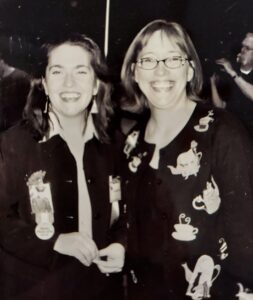
Me and Annie Jones, circa 1997
Early on, we targeted Harlequin Enterprises, the biggest publisher of romance, for our manuscripts. Harlequin had purchased competitor Silhouette Books, plus Mills & Boon, the iconic publisher of romances in the UK, Europe, and Australia (Barbara Cartland, anyone?). Harlequin released dozens of romance novels every month all over the planet in dozens of languages. The books were known as “category” romances meaning a certain type of romance was released under a “line”—Silhouette Romance and Harlequin Romance were shorter, sweeter romances, while the Harlequin Presents line featured international settings with more sweeping stories. Other lines featured romantic suspense, family drama, and historical storylines.
(If you’re interested in the history of romance novel publishing, check out the Harlequin About Us page and scroll down to Our History. Also, you might enjoy For Love and Money: The Literary Art of the Harlequin Mills & Boon Romance and A Natural History of the Romance Novel.)
The star of category romances is the “line” over the author—if a reader subscribed to a line, they received four or six books a month through the mail, and readers who purchased books in person would likely buy the entire line for that month. Writing for category romance was a boon to beginning writers because the audience for the line was already established. A new writer could reach untold numbers of readers and begin to build name recognition, so selling a manuscript to Harlequin was akin to hitting the career lottery—if not in terms of money, then in terms of exposure. I bought and read countless romance novels to narrow down the lines I wanted to target.
Every week Annie, Beth, and I exchanged pages of our manuscripts, giving feedback on what was working and what needed to be fixed. I learned so much by reading their pages and tried to apply what I’d learned to my own pages. I had stuck to my decision to write contemporary romance and because I enjoyed reading family dramas and watching them on TV, those were the kinds of stories I wrote. Although the stories had a happy ending, they were riddled with conflict and emotional ups and downs about serious family issues.
When we deemed our manuscripts were “ready,” we submitted them in cumbersome envelopes to faceless editors in Ontario and New York, along with the requisite self-addressed envelopes stamped with enough postage to return our manuscript in the (very likely) event the editor rejected it.
It would literally be months before we received a response to our submissions. We’d heard that good news always came in the form a phone call, and bad news came in the form of a returned manuscript. The "best" bad news one could hope for was a personal note as to why the manuscript had been rejected and occasionally, an invitation to resubmit once the problems had been addressed. I remember well opening my mailbox and hoping NOT to see a returned manuscript, but that’s what I received every time, and always with a form rejection letter, with no hint of why my manuscript had been rejected and no invitation to submit again. (Note: I’m away from my archives as I write this, but I think I kept some of my rejection letters and if so, will post them here at a later date.) After a rejection, the only recourse was to revise the manuscript to fit another line and resubmit it, or to start a new project. Annie, Beth, and I bonded over many rejections and despite the disappointment, I loved every minute of it because I was learning so much.
(Oh, how times have changed! Now the information my friends and I worked so hard to get our hands on is available at the click of a button. If you’re interested in writing for Harlequin, check out their Write for Harlequin page.)
During this time I was also enjoying my full-time job as a systems engineer. The department I worked in at Ashland Oil (now Marathon) was staffed with eager, talented IT professionals and in hindsight, it’s incredible the amount of work the group churned out collectively. Every day I felt as if my brain was firing on all cylinders. At one point my manager was out on maternity leave and the senior systems engineer I reported to had recently left. At the same time, a high-profile system I supported (Stockholder Records) was tasked with implementing a two-for-one stock split which, for obvious reasons, had to be undertaken in secret. I worked evenings and weekends, but still found time to write fiction an hour here and there. Writing was a break from my busy corporate job, although I still didn’t view it as a replacement vocation. My goal was to sell a book or maybe two as a hobby and for personal enrichment.
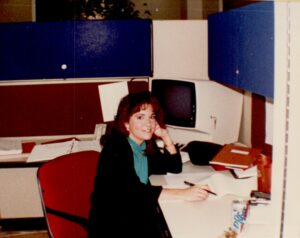
My first day working at Ashland Oil (now Marathon) in Lexington, Kentucky, May 1987.
Get a look at that huge computer terminal, and the 1980s primary colors in my 6’x6’ cubicle.
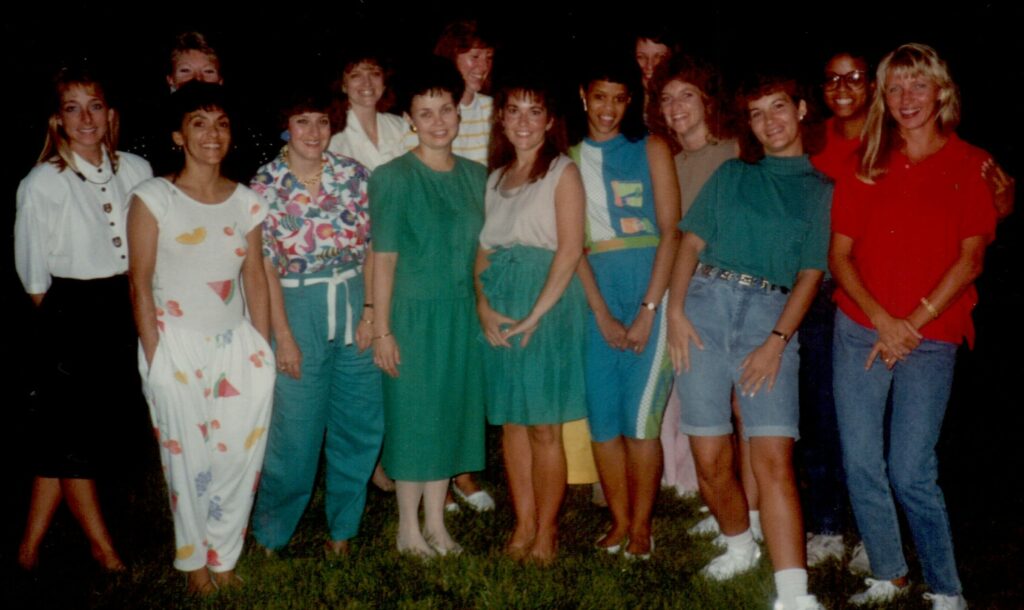
Some of my coworkers at Ashland Oil, Lexington, Kentucky, circa 1990.
These ladies were some of my biggest supporters when I finally published a book.
Then in 1995 my spouse was offered a promotion by his company to relocate to Atlanta. My company had a division in Atlanta, so I put in for a transfer. I also attended the national Romance Writers of America conference in NYC, which opened my eyes to the business side of the writing industry. While there, I found someone who belonged to the Georgia Romance Writers (GRW) group and made arrangements to join when I got there. Sadly, I said goodbye to my critique partners in Lexington, both of whom were now getting “good” rejection letters, and I moved to the suburbs of Atlanta.
The move to a bigger city was exciting, but early on, I realized the atmosphere in the division I’d transferred to wasn’t as upbeat or dynamic as the department I’d left. Conversely, the large GRW contingency was made up of accomplished novelists and (mostly) women who were determined to educate and uplift each other. Every monthly meeting was a heady mix of business bootcamp and pep rally. After the meetings we caravaned to a Waldenbooks (remember them?) to buy books written by members that had been released that month. I was in awe of the writers who’d published 10, 20, even 30 books! For the first time, I began to wonder if I could make a living writing romance novels and decided it was time to get serious about my writing. Meanwhile, I was cheering on my former critique partners in Kentucky who both had recently sold their first manuscripts to Harlequin and Silhouette.
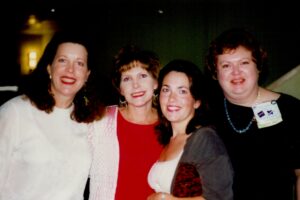
Members of Georgia Romance Writers, from L to R:
Lyn/Virginia Ellis and ½ of Raven Hart, Rita Herron, me, Susan Goggins/½ of Raven Hart
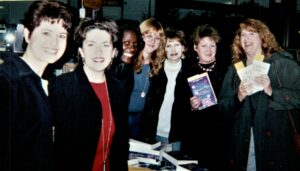
Members of Georgia Romance Writers, from L to R:
Jacquie D’Alessandro, me, Carmen Green, Jennifer St. Giles, Rita Herron, Jennifer LaBrecque, Anna Adams
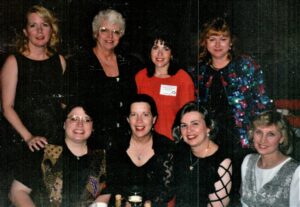
Georgia Romance Writers members, standing, L to R:
Patricia Van Wie, Sandra Chastain, me, Jennifer St. Giles
Seated, L to R: Debra Dixon, Lyn/Virginia Ellis and ½ of Raven Hart, Ann White, Donna Sterling
One Saturday in line at Waldenbooks I met Rita Herron who would become my longtime critique partner and closest writing friend. In Rita I found a kindred spirit who was as ambitious as I was. (Rita is SO prolific and successful, check out her website here.) We began to meet every week to exchange work and I was reinvigorated, bolstered by the events sponsored by GRW.
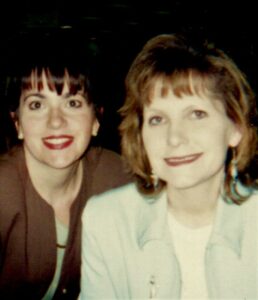
Me and longtime critique partner Rita Herron, circa 1996
One of the GRW events featured Harlequin editor Brenda Chin, who acquired for a family drama line I was targeting. She read aloud anonymous query letters that pitched an idea for a book, then she commented on which ones she would request and which ones she might pass on, and why. I’d submitted a query letter for a story I was writing, and I was excited when she read my letter aloud. At the end of it she said she’d be willing to read the manuscript, so the author could go ahead and submit it. Then she added that she’d like to talk to the person who’d written the letter, so would the author please find her afterward?
I was a nervous wreck but after the event I walked up and introduced myself. Brenda was surprisingly friendly and said she was actually acquiring for a brand-new romantic comedy line that hadn’t yet been announced, and she thought my query letter had a light and funny “voice.”
“Do you write romantic comedy?” she asked.
I had a decision to make. I didn’t write romantic comedy—no one had ever told me I was funny and in fact, most people would say I was the opposite of funny. I didn’t tell jokes and I didn’t always get the punch lines of other people’s jokes. But I also recognized the enormous opportunity of an editor standing in front of me asking if I wrote something she was looking to buy.
“As I matter of fact, I do write romantic comedy,” I lied.
She smiled, then asked me to tell her about a rom com I’d written.
My mind raced. I’d recently read a story about pheromones used in perfumes, so I opened my mouth and said I was writing a story about a woman who signs up for a clinical study on pheromones and becomes irresistible to every man she meets.
Brenda nodded. “I like it. How much of it’s written?”
I was sweating now, but in for a penny, in for a pound. “Oh, it’s one of those books that seems to be writing itself. I can send you a polished proposal in a week or so.”
She said great, she’d be looking for it, then gave me her card and went on her way.
Gulp! My heart is racing as I write about it even after all these years. I’d just promised to send an editor a synopsis and three chapters of a story I’d thought of on the spot and for which I didn’t have a single word written.
It was time to put up or shut up. ~
→ Go to Chapter 3: Writing and Selling my First Book
One of my earliest memories is reading, or more probably—holding a book and pretending to read. And I remember being so jealous when my brother, who’s three years older, went to school. I couldn’t wait to get to that mysterious, exciting place where he got the textbooks he brought home in his satchel (another item I envied). But when I arrived at Clark Hill Elementary in Olive Hill, Kentucky, to my great disappointment, first graders didn’t do a lot of reading—that treat was reserved for second graders. But since it was a small school where first and second grade shared a room, I got to listen as Miss Alice Sue Dehart taught reading to the older grade, and at recess she let me flip through the giant red storybook that sat on an easel and featured adventures of Jimmy and Sue and their dog Pepper.
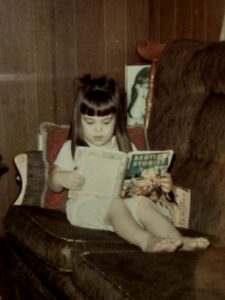
Me at age 3 curled up with a book titled Bedtime Stories.
I loved words and reading came easy to me. I exhausted the closet-sized elementary school library that was underfunded and understocked but contained a handful of books from incomplete series like Nancy Drew and Hardy Boys, with some classics like Heidi and A Tree Grows in Brooklyn. My small hometown didn’t have a public library at the time, but at home I scoured our set of Encyclopedia Britannica and read Progressive Farmer magazine cover to cover. (This is where I should mention I grew up on a working farm—cattle, tobacco, and a huge garden. If Progressive Farmer is a nostalgic reference for you, you might enjoy this vintage book of wisdom from the magazine titled Cornerstones, printed in 1990.)
My dear mother subsidized my early reading with bookclubs—every month or so an envelope of two hardcover books would arrive and I’d read them in like, an hour. But I remember them being obscure and literary—even then I gravitated to genre books! A couple of times a month, I spent my allowance at Ben Franklin’s Five & Dime on Nancy Drew and Trixie Belden mysteries, determined to accumulate my own library on the bookshelf my father made (and I still have). Over the years my immediate and extended family contributed to my 52-book set of Nancy Drew books on birthdays and holidays, a collection I cherished and maintained for over 40 years before passing them along to young cousins.
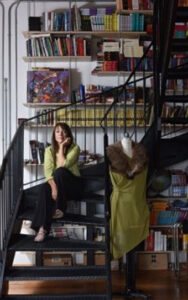
Me circa 2014 sitting on the stairs in my Atlanta loft with my prized set of yellow Nancy Drew books on the shelf behind me.
In fourth grade my teacher Miss June Ross made each of us stand up and say what we wanted to be when we grew up. I bounced out of my desk because that was easy—I was going to be a librarian, of course, so I could be surrounded by books! (I’m sure the other kids groaned and considered me an annoying four-eyed goody-two-shoes.)
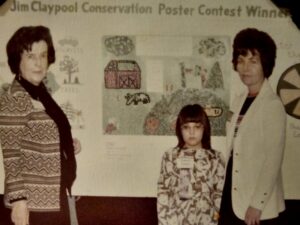
Me, age 9, between my teacher Miss June Ross and my mother Bonnie Bond.
That same year Miss Ross gave me an autographed book titled Old Ben by famed Kentucky author Jesse Stuart. It was a revelation—real people wrote books? I wrote to Mr. Stuart to tell him I enjoyed the story, and he sent me back a postcard, both of which I still have. I especially cherish that Miss Ross wrote her name in the book. She was an influential teacher who escorted me to local and tri-state spelling bees and told me stories about her life. She was single and wore silver-colored loafers, and I thought she was utterly glamorous.
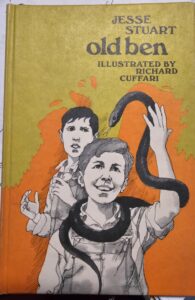
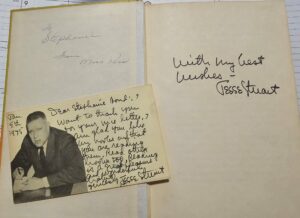
The cover of Old Ben, inside inscription from my teacher Miss Ross, autograph and postcard from legendary Kentucky author and poet Jesse Stuart (1906-1984) dated January 5th, 1975. The postcard reads “Dear Stephanie Bond, I want to thank you for your nice letter. I am glad you like my books and that you are reading them. Read other books too. Reading is a great pleasure and wonderful habit. Sincerely, Jesse Stuart.”
Once I asked about a scar on Miss Ross’s leg. She told me when she was young, she’d been in a terrible car accident. She said it wasn’t her only scar and she’d been in a coma for some time after the accident, then added she could remember everything that happened when she was in the coma. That story stuck with me, but I’ll tell you more about that later.
Somewhere around fifth grade, my aunt Fonda, who lived in Ohio and was an avid reader, began to bring me huge bags of paperbacks—gothic novels by Phyllis Whitney and Victoria Holt and Harlequin Romances (the sweet ones). I thought I’d died and gone to heaven and since entertainment on the farm was slim pickings—we had two TV channels and shared a multi-family party-line phone—I tore through the paperbacks at the rate of one a day. And my voracious reading habits continued into high school.
My sophomore year, English teacher Miss Nancy Mackenzie decided to deviate from our textbook lessons. She read to the class the beginning of a story, then challenged us to write our own ending. It was as if she had set my brain on fire. I wrote my ending and handed it in. The next day she picked three papers to read aloud and to my amazement, one of them was mine. For two weeks she repeated the writing exercise, and it became my goal to be one of the top three “endings” she read aloud. Yet as much as I loved the assignments, it never occurred to me that I could be a fiction writer.
By the time I graduated high school, I had forsaken my nine-year-old dream of becoming a librarian to focus on business and math classes. When I enrolled in Morehead State University in 1983, I threw myself into learning computer programming, which was then a fairly new field of study. In the wake of my intensive schoolwork, my fiction reading fell by the wayside.
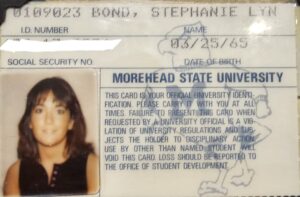
My student ID from Morehead State University where I studied the then relatively new field of computer programming. At the time the school’s main computer didn’t have its own compiler so MSU “borrowed” another university’s compiler from midnight to 6 a.m., which meant we programming students couldn’t begin our homework until the witching hour!
While attending college I worked part-time at a shoe store that was marginally successful. The owner began to spend more and more time away from the business, so I took on more responsibility—it was like small-business bootcamp. When the owner decided to sell, I bought the business, changed the name to Boots & Britches, and for two years, specialized in selling boots and Levi’s jeans in between my full load of classes.
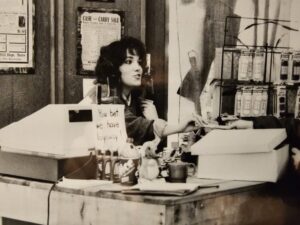
Me at my retail business Boots & Britches, circa 1985. It was a great business education and would later inform my decision to launch a self-publishing business.
Upon graduating college, I sold my retail store and went to work for Ashland Oil (now Marathon) as a systems engineer in Lexington, Kentucky. I loved my job supporting the company's stockholder records system, but the hours were long, and I was still too busy to read for fun. (In hindsight I realize reading is a habit that’s easy to fall out of because it feels so indulgent and excludes others.) Fast-forward a couple of years—I was now married and decided to pursue an MBA at night. Getting my master’s degree took me five years, but it turned out to be a life-changing event.
I was taking the capstone course of the program and one of the requirements was to write a comprehensive paper on a business project we’d chosen. I’m not positive, but I believe mine was on integrating a cafeteria-style benefits program, which was a new concept at the time although not exactly a riveting topic! Anyway, when the professor returned my paper, he made the comment that he thought I could get the paper published. I remember being confused and repeating, “Published?” He looked at me quizzically and said hadn’t anyone ever told me I had a flair for writing? I said no. He went on to say he thought I should submit the paper to business journals, but I remember utterly zoning out. It was as if all the “happy” moments in my school and work career came rushing at me. I'd always been the person electrified at the prospect of writing papers, book reports, business plans, progress reports... and I recalled vividly the writing assignments back in sophomore English class—it all made sense now.
And the thought slipped into my mind, I wonder if I could write a romance novel?
My professor would’ve been scandalized if I’d told him what I was thinking, so I kept my mouth shut. But the seed was planted. The following week, my night classes were over, and I finally had some free time on my hands. I pulled my long-neglected collection of romance paperbacks from dusty boxes and reacquainted myself with the thrill of reading for pure pleasure. I didn’t know if I could create a story that would transport others the way stories had transported me, but I felt compelled to try.
So I booted up my IBM 387 desktop computer, opened a blank file in WordPerfect, and began to type. ~
Note: If you purchase items from links on this page, the owner of the site may earn a small affiliate commission.